If it weren’t for my perennial vegetable garden (seen above in the feature image), I think I would’ve given up on growing food a long time ago.
In case you’re wondering, you’re looking at—from left to right—rhubarb, walking onions, thyme, oyster leaf, and rosemary, with Jerusalem artichokes, asparagus, and oregano in the back.
Not seen, though they’re growing in the same beds, are red-veined sorrel, true French sorrel, common garden sorrel, mitsuba, lovage, sea kale, potato onions, onion chives, and garlic chives. All perennials in my Zone 5 microclimate. And that’s just one corner of my garden!
While there are few rewards greater than growing your own food, the realities of gardening are that it can get expensive, plants seem to die for no reason, pests sometimes get the best of us, and the chaos of prepping the garden in spring (or cleaning up in fall) definitely takes its toll.
Which is why I love having perennial vegetable beds that basically take care of themselves.
In my own garden, I grow dozens of varieties of perennial vegetables (as well as perennial herbs) that come back year after year in my Zone 5 microclimate—some that I simply mulch over winter, and some that need only a midweight frost cover to survive our winters.
These plants are the first to get going in late winter to early spring with new growth, and they take all the pressure off having to sow seeds or transplant seedlings on time.
They know exactly when to come up, produce all season, die back when it’s time, and do it all over again next year, with hardly any work on my part (other than mulching, watering, and harvesting). Sounds dreamy, right?
If this is something you can get on board with, I’ve compiled a list of my top 31 perennial vegetables to grow in a home garden, categorized by alliums, leafy greens, stems and shoots, tubers, and other vegetables that you may not have known were perennials!
I’ve personally grown most of these crops in my own gardens (between Southern California and Central Oregon) so I can say they’re worth it—if not for their culinary uses, then for their ornamental value in the landscape.
Alliums
Garlic (Allium sativum)
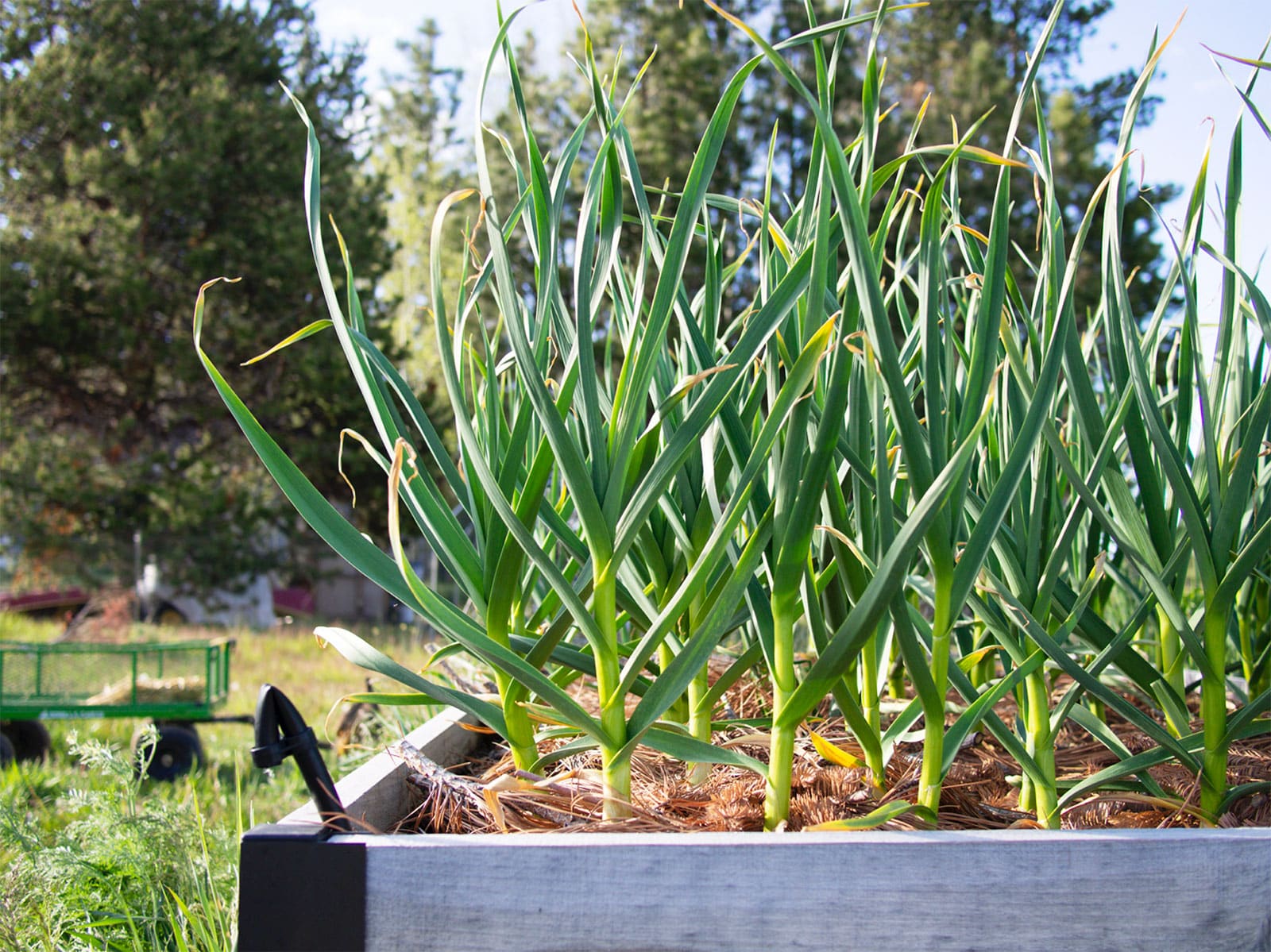
Good old garlic is an excellent example of a perennial vegetable, even though most people grow it as an annual.
But if you leave your bulbs in the ground, they’ll continue to divide and regrow year after year, giving you an endless garlic patch where you can harvest delicious garlic greens in early spring, gourmet garlic scapes in late spring, and pungent heads of garlic in summer.
It’s wonderfully easy to grow, there are tons of different garlic varieties to try, and it’s edible all the way from the bulb to the flowers.
If you’d like to give growing garlic a try, it can be as simple as popping a store-bought bulb into your garden in fall. For the best results, though, choose the best cultivar based on where you live.
Softneck garlic, which is what your local grocery store will usually carry, works well between Zones 6 to 10.
If you live in a colder region (Zones 6 and below), try hardneck garlic. Although it has a shorter shelf life than softneck types, it’s hardy as a perennial all the way down to Zone 0.
You can find more info in my full guide to growing your own garlic!
Leek (Allium ampeloprasum)
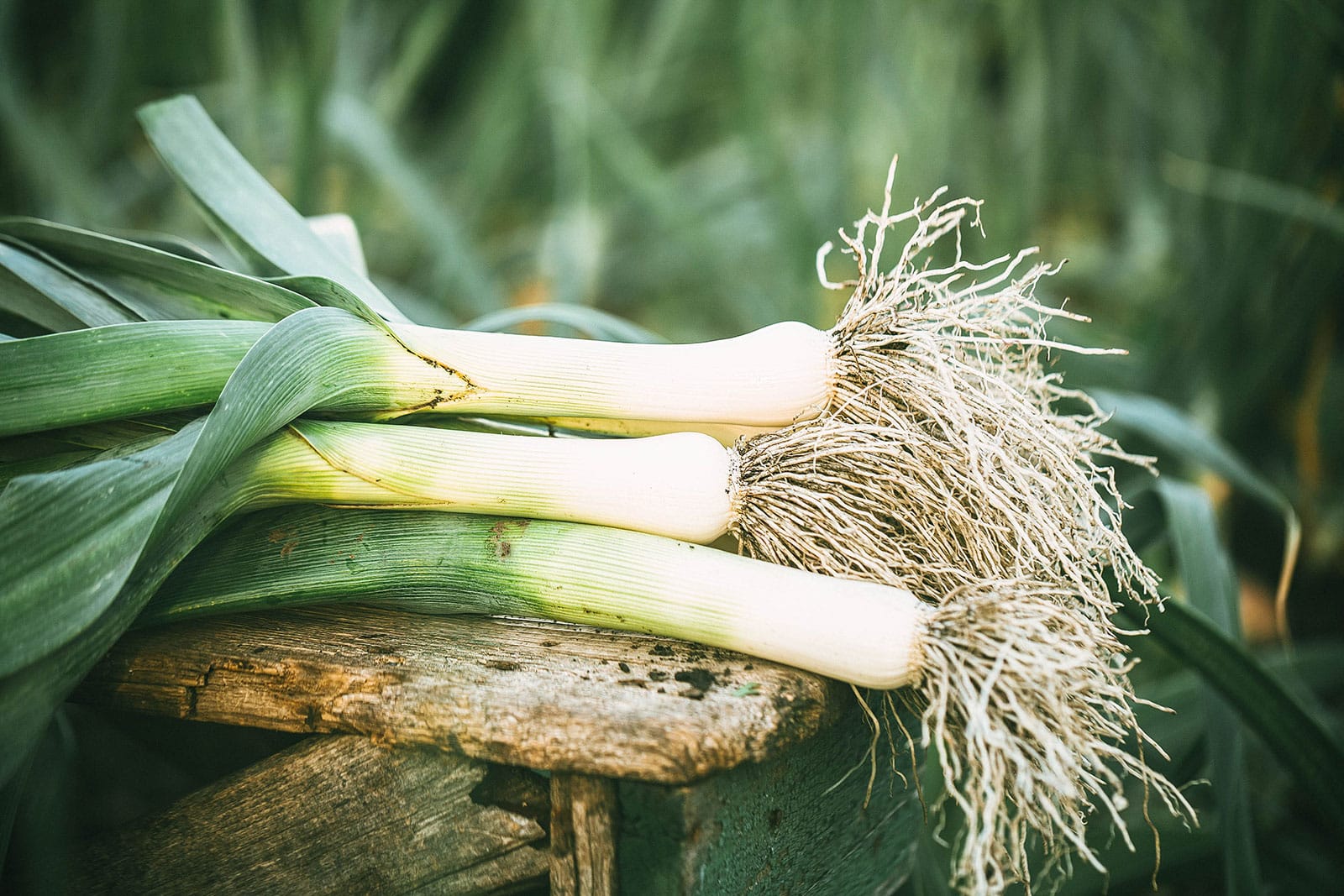
Here is the humble leek, the star of so many quiches, gratins, and soups.
If you’d like to grow leeks as a perennial crop, it’s important to keep in mind that there are a bunch of different cultivars and varieties.
Some, called summer leeks, aren’t very hardy. They won’t make it through winter unless you live in a mild or moderate climate.
Winter leeks are a different story. In Zones 7 and up, they will grow year-round without any help. This can be stretched to about Zone 5 with generous mulching.
You can start yours in spring or fall, but keep in mind they do take a good while (up to four or five months) to mature into quiche-worthy vegetables.
Potato onion (Allium cepa ‘Aggregatum’)
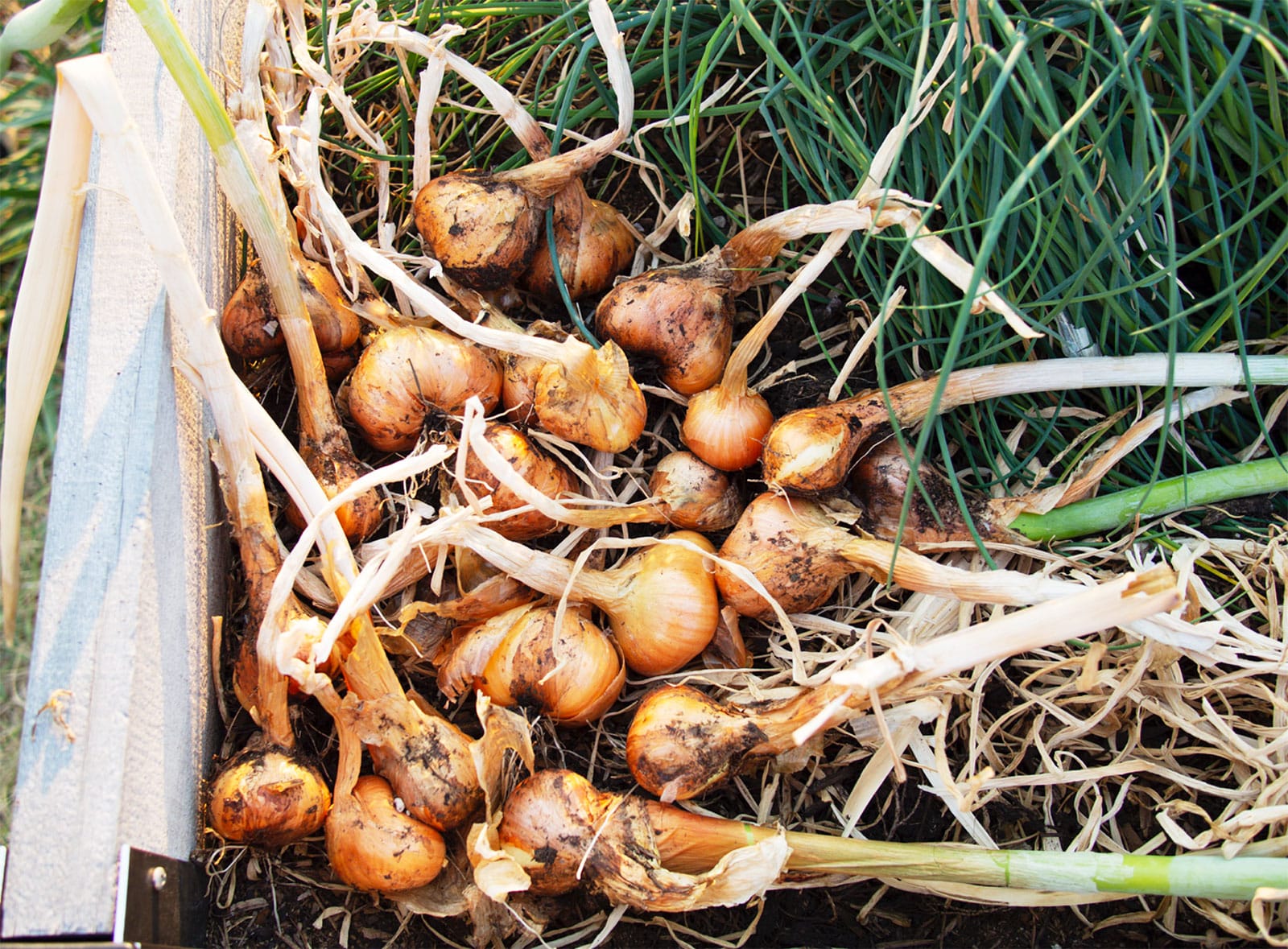
Although “regular” onions don’t really work as perennials, a few of its cousins do. One of the most popular options is the multiplying onion, also known as the potato onion.
As with shallots, potato onions multiply through bulb division more than they do through seed.
If you’re already planting garlic and shallots, there’s no reason not to add a handful of potato onions as well. They’re grown the same way: plant in fall, harvest in late summer.
Save a few of those potato onions and use them to replant the crop that fall. By saving and replanting your potato onions, you can keep your crop going indefinitely.
So what happens if you don’t harvest in fall? The potato onions will sprout again come springtime! (Although the plants will get pretty crowded since every onion left underground develops a shoot.)
It’s great for Zones 3 to 9, although this crop does need a little protection during winter in colder climates—I like to add a few inches of straw mulch on top. After harvest, I store my potato onions the same way I store regular onions.
Did you know?
One thing gardeners tend to appreciate about potato onions is that they rarely flower. Although onion flowers are edible, the bulb stops growing when they appear, which is why they’re generally considered undesirable.
Shallot (Allium cepa)
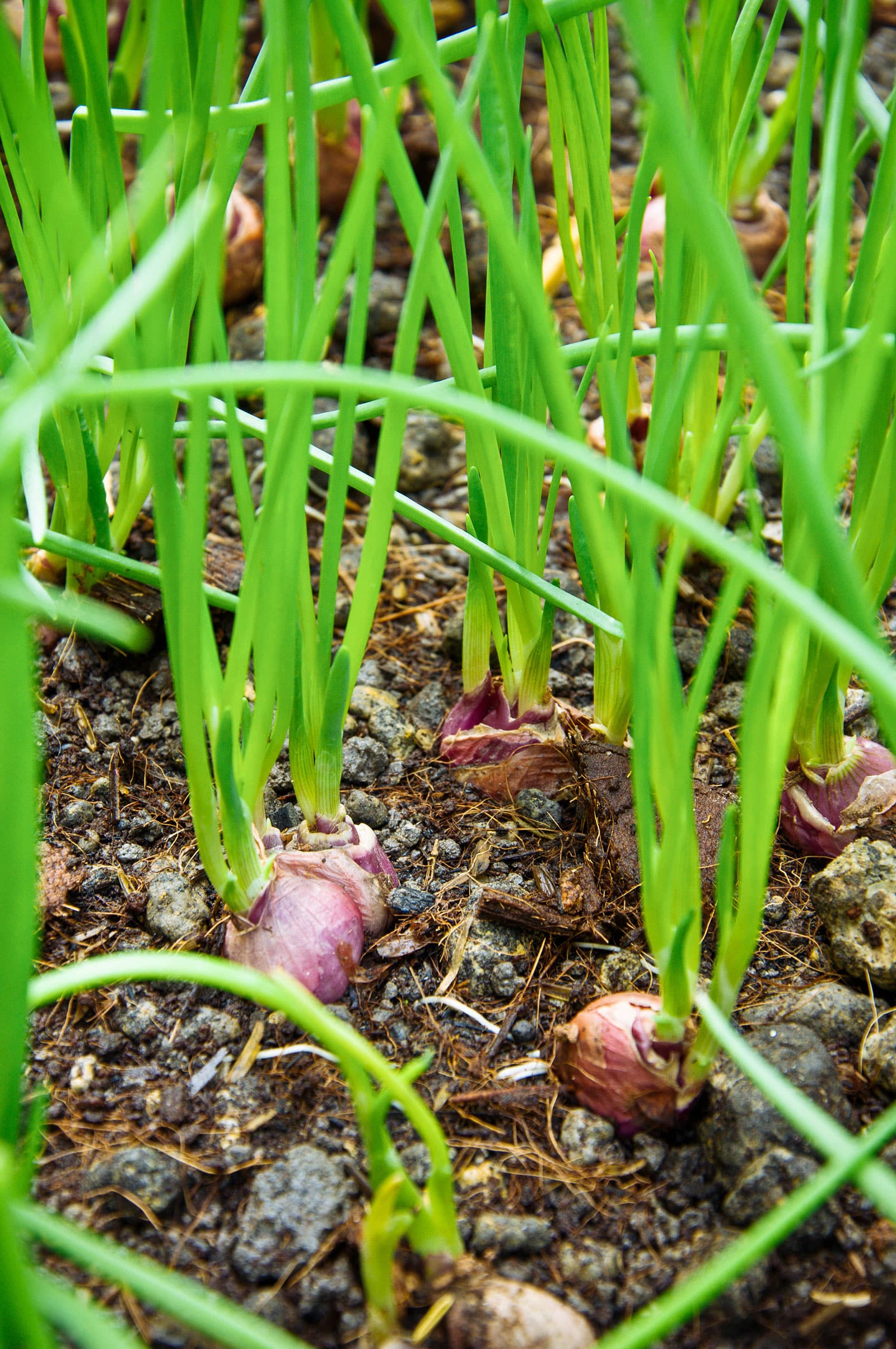
Garlic and leeks aren’t the only members of the Allium (onion) genus that can be grown as perennials.
Shallots, those mild mini onions we all love for vinaigrettes and salads, are usually grown as annuals but can actually be maintained year after year in the right environment.
Growing shallots is quite similar to growing garlic. You can do so between Zones 3 to 9, provided you offer some extra protection in winter by covering them with mulch in colder areas.
Plant the shallots in fall, a few weeks before the first frost, and you should be able to harvest the first bulbs by late summer the next year.
Walking onion (A. × proliferum)
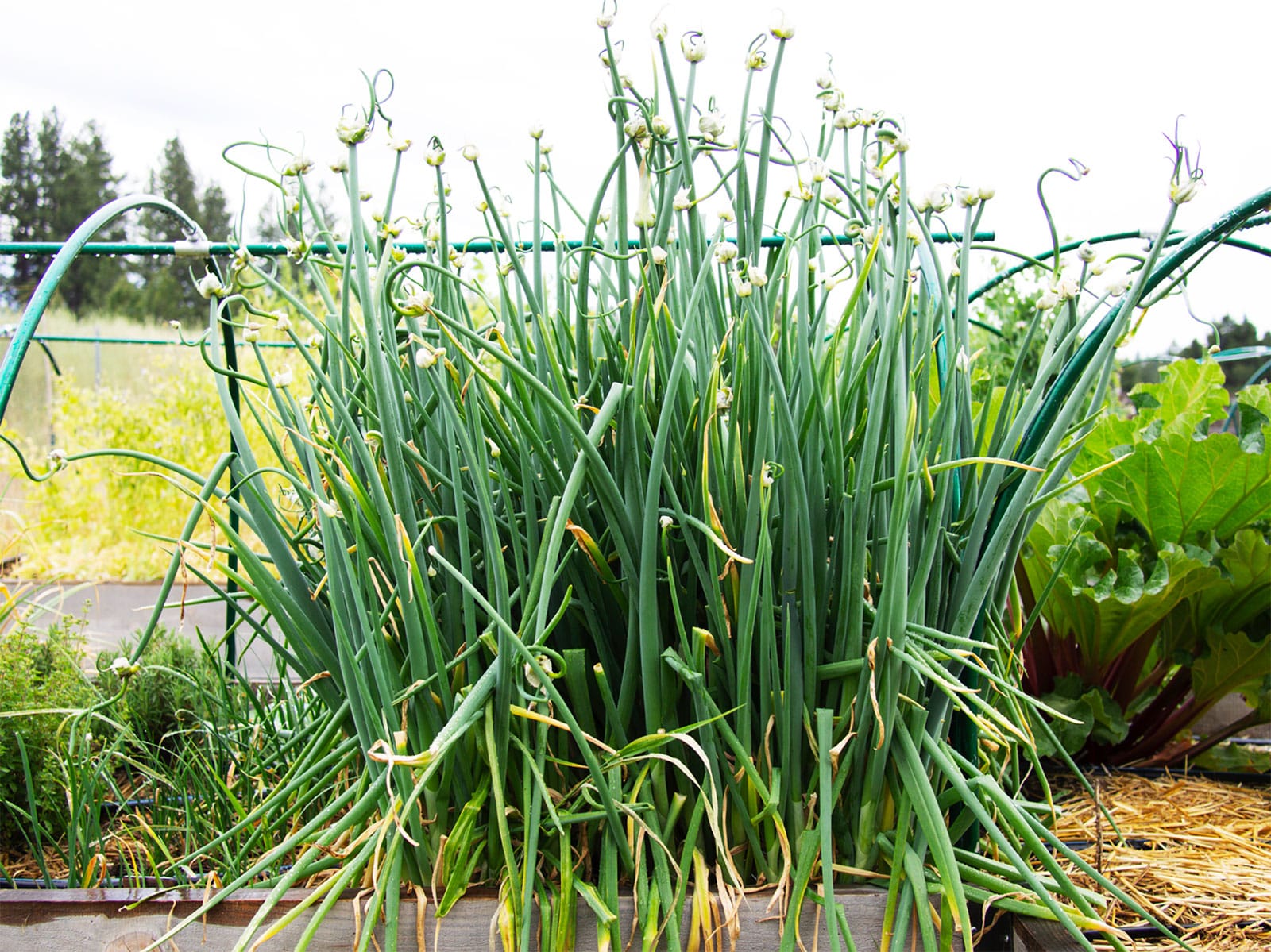
If you like your onions perennial rather than annual, you can also consider growing my favorite perennial onion, the walking onion.
Also known as an Egyptian walking onion or tree onion, this variety is a hybrid between cultivated onions and Welsh onions (discussed below). The tender green stems are used like scallions from spring through fall.
What sets the walking onion apart from many other Alliums is the fact that it doesn’t really produce flowers.
Instead, the plant produces a cluster of tiny bulbs (called bulbils) right near the top. These look a little like baby onions and are, of course, edible. (I usually roast or grill them whole, skins and all.)
If you leave walking onions alone, they will eventually flop to the ground and (re)establish themselves. Knowing this, it’s not difficult to understand where the walking onion got its name!
This is a crop that can keep on multiplying, so it’s important to harvest the bulbils if you don’t want the plants to grow too thickly or spread too far.
The vigorous walking onion is easy to grow between Zones 3 to 10. Just treat yours like garlic or shallots and you’re golden.
Welsh onion (Allium fistulosum)
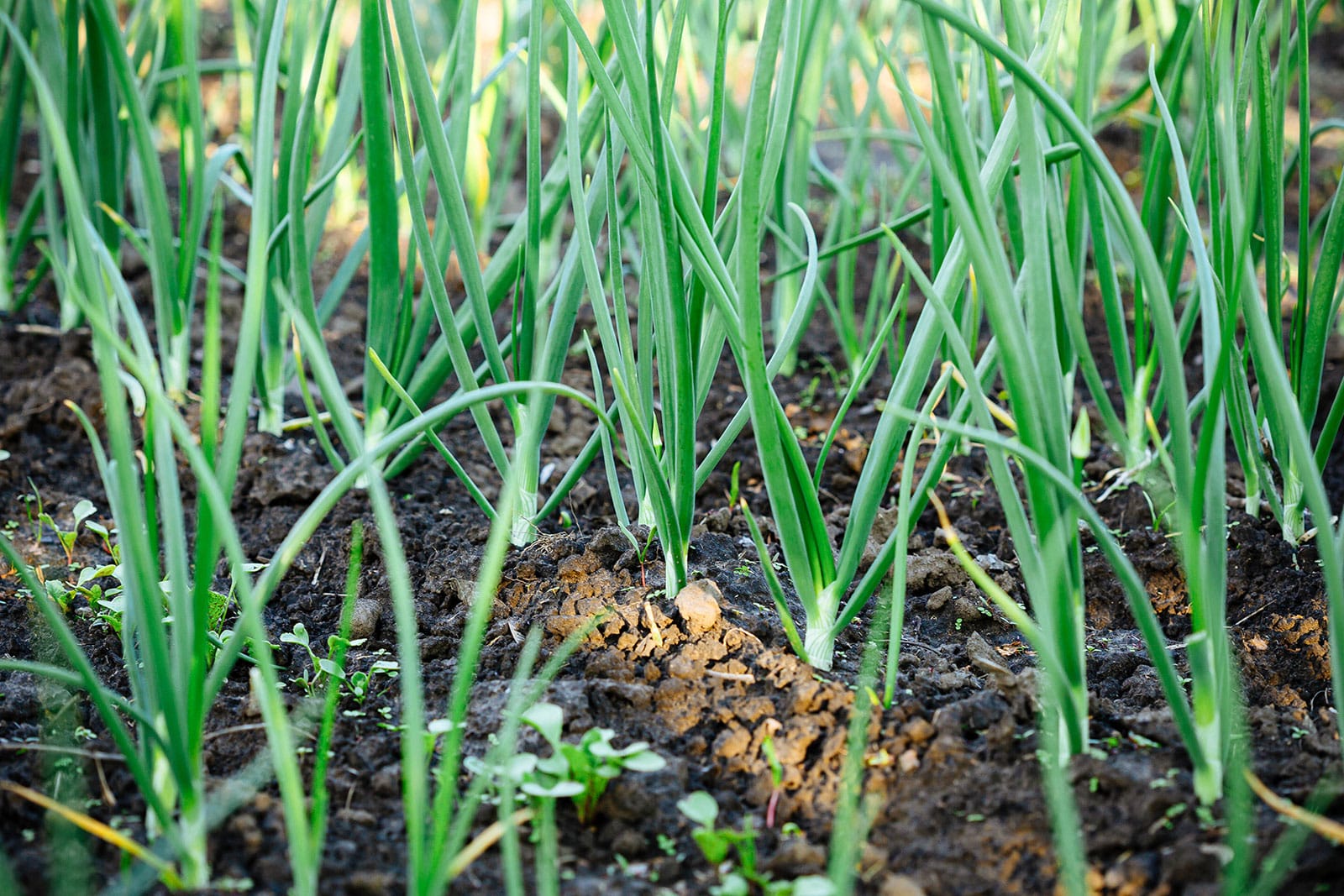
I just mentioned the Welsh onion—here it is, and it’s another perennial.
A type of scallion scientifically known as Allium fistulosum, this species isn’t actually from Wales at all; it originated in China, although it’s now appreciated worldwide for its edible leaves and stems.
It doesn’t tend to grow large bulbs like many other onion species, instead forming clumps of green stems with white ends (on some cultivars, the ends are pinkish-purple).
You’ve most likely heard this type referred to as bunching onions, Japanese bunching onions, or spring onions. In other words, green onions!
In the garden, like their other Allium cousins, Welsh onions like plenty of sun. You can grow them in well-draining soil in Zones 3 to 9, planting them in early spring or late fall.
The harvesting season is nice and long, so you’ll be able to enjoy the leaves all the way from early summer to fall.
Leafy greens
Dandelion (Taraxum sp.)
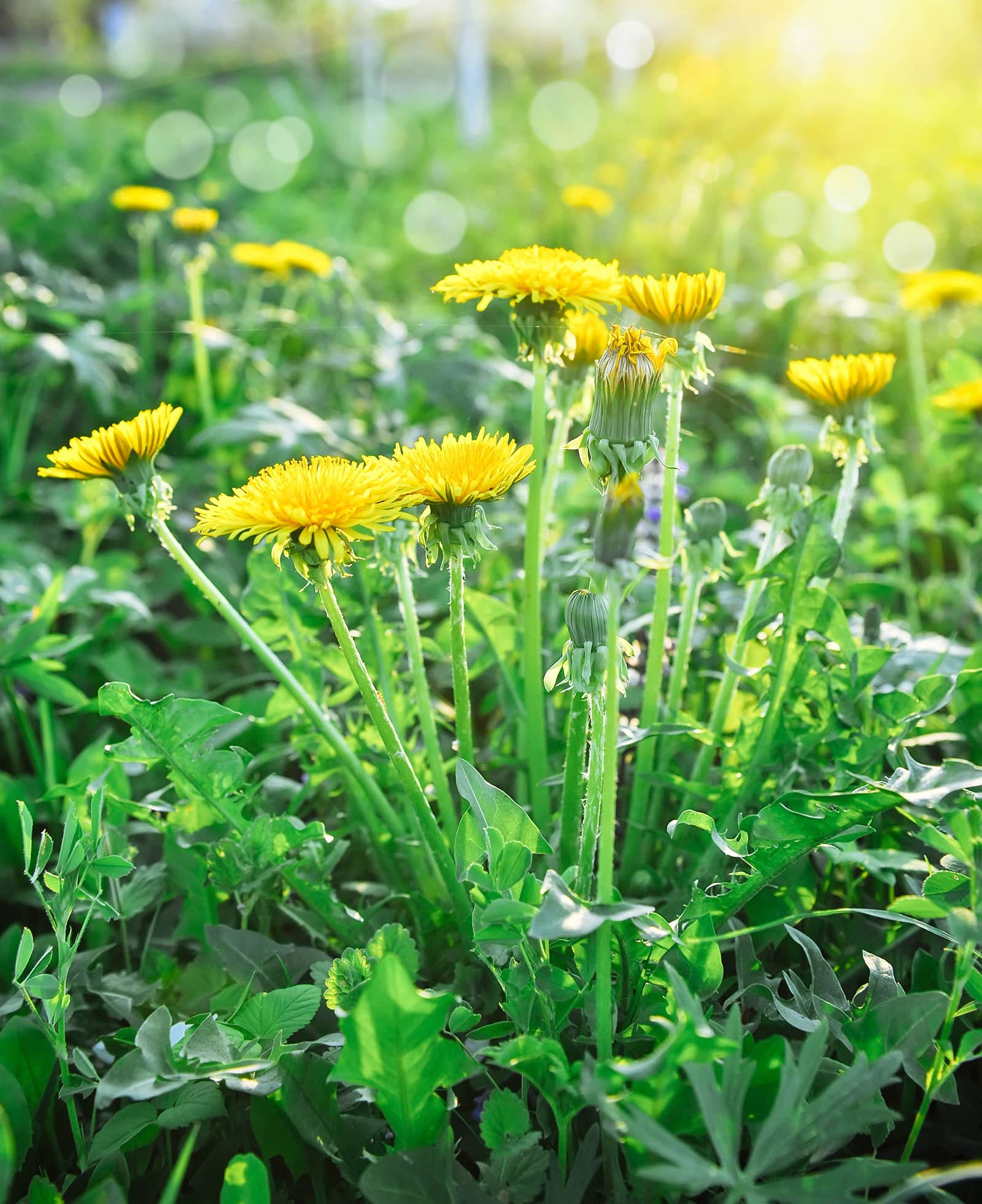
Dandelions have a special place in my heart.
Sure, they have a knack for never staying where you want them to in your garden, but dandelions are so useful! Pollinators love them, and more importantly for us humans, they’re also edible and in fact pretty versatile.
I probably don’t have to tell you how to grow dandelions, including the decorative but just as edible pink dandelion (Taraxum pseudoroseum), as they mostly grow themselves.
Just toss them in a planter as ground cover or pop them into the garden between Zones 3 to 10 to enjoy their flowers and leaves every spring.
For those who aren’t sure how to use dandelion, here are some of my favorite options:
- Use the leaves in salads or in a stir-fry
- Roast or boil the root
- Make dandelion flower fritters
- Turn the flowers into dandelion jelly
Good king Henry (Blitum bonus-henricus)

I’ve previously mentioned Blitum bonus-henricus, also known as good-king-henry, in my post on perennial herbs.
As you can read there, though, this plant is also used as a vegetable. Or maybe I should say it was used as a vegetable; like many of the perennial vegetables on this list, it has fallen out of fashion somehow.
A species of goosefoot naturally found in central and southern Europe, good-king-henry produces edible leaves that make a decent spinach replacement.
The young shoots can also be eaten and are actually sometimes called “poor man’s asparagus.”
Another one of those plants that are often considered weeds, this one’s easy to grow in your garden. You can maintain it as a perennial in Zones 3 and up. Just give it plenty to drink throughout the growing season.
Malabar spinach (Basella alba)
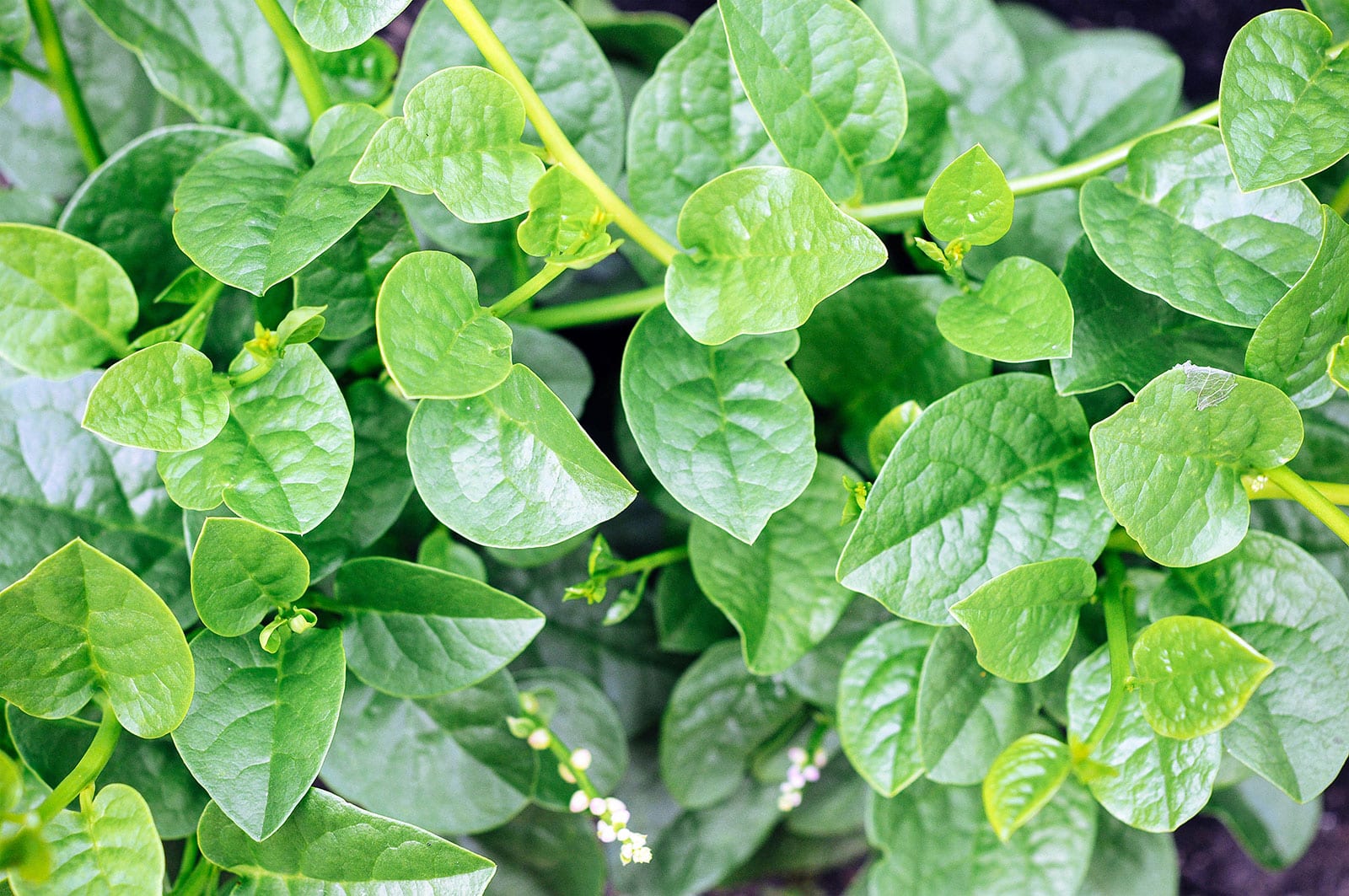
Although it’s not related to true spinach, Malabar spinach (Basella alba) can make a darn good alternative.
Naturally found and widely used in much of Asia, this perennial climbing plant tastes great in a nice dal, stir-fry, or soup. It’s somewhat mucilaginous when cooked, almost like okra, and lightly peppery. It can also be used raw in salads.
One great thing about Malabar spinach, which I also discussed in my post on heat-tolerant salad greens, is the fact that it thrives in hot summers.
Unlike true spinach, which is decidedly a cool-weather green, Malabar spinach will continue growing and producing edible leaves all summer long.
This leafy vegetable can be grown as a perennial in Zones 7 to 10. It’s a tropical, so it loves being nice and warm. It also requires plenty of water to keep the leaves from going bitter.
Nine Star perennial broccoli (Brassica oleracea)
Another totally obscure perennial vegetable (for Zones 8 and up) that I think more home gardeners should become familiar with is ‘Nine Star’ broccoli.
This heritage variety is pretty rare nowadays, maybe because its crops just aren’t as big as those of normal broccoli, but it’s honestly such a gardening life hack.
Neverending broccoli? Yes please!
If you’re familiar with sprouting broccoli, you’ll find ‘Nine Star’ perennial broccoli to be similar. The difference is that rather than the purple heads of sprouting broccoli, this variety produces off-white heads that are more similar to cauliflower.
One central head appears first, and after this has been harvested, multiple smaller ones—often around nine—will pop up.
If you plant your ‘Nine Star’ broccoli in spring, you can expect a good harvest the next year. Just use the sprouts like you would normal broccoli.
Once the plant begins to lose traction after around five years, you can propagate it or plant new ones.
Oyster leaf (Mertensia maritima)
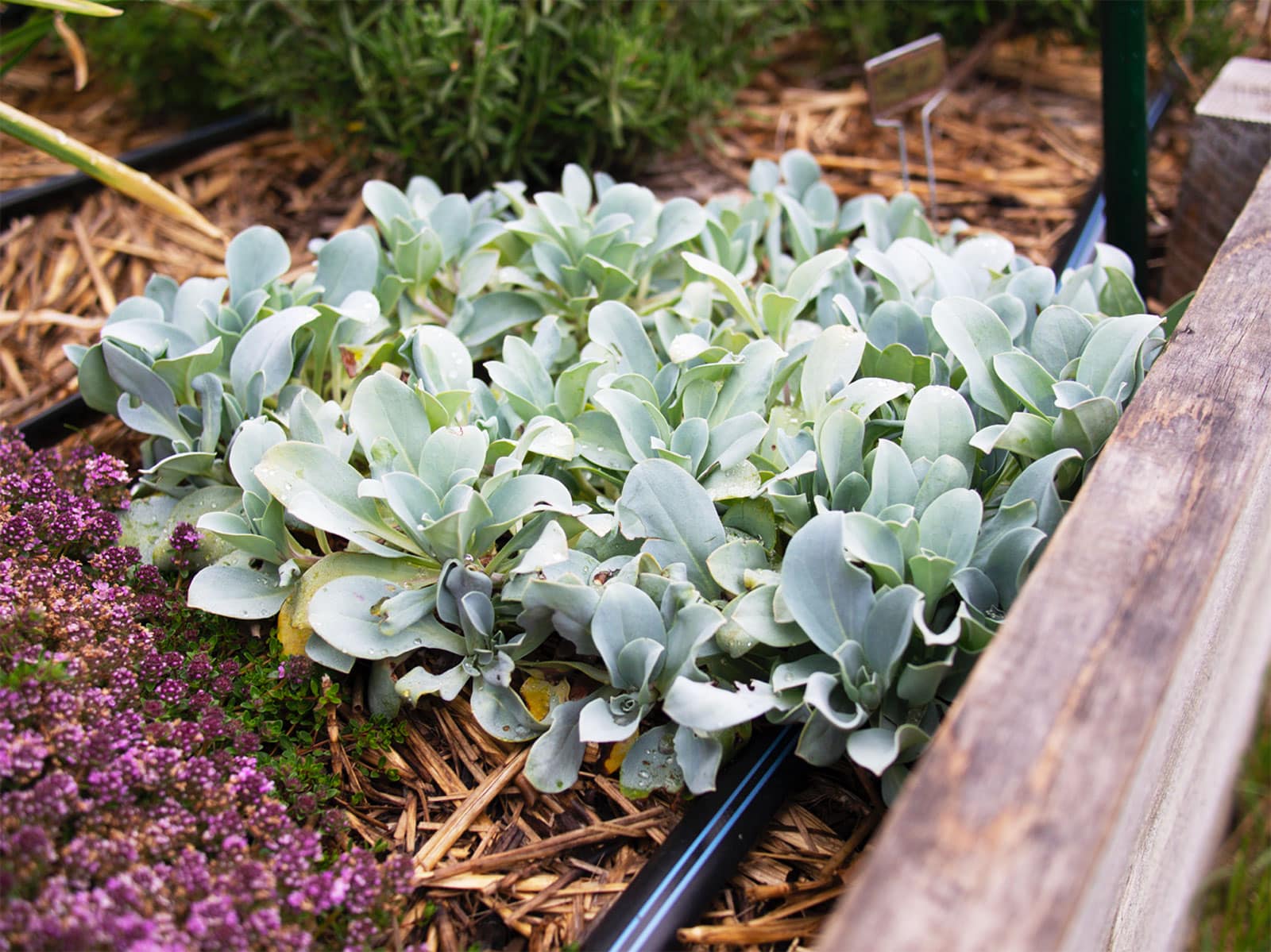
If you’ve never tried it before, you may be surprised when I tell you that the oyster leaf plant (Mertensia maritima) didn’t get its common name from its leaf shape or anything like that.
Nope, it’s the flavor: briny and somewhat earthy, just like an oyster, though significantly less pungent. Great if you want a vegan replacement for those tasty bivalves, or if you’re just looking to try something new.
I like to use my oyster leaves fresh to really showcase their flavor. One go-to is to mix them with microgreens to make a simple salad that I then plate under grilled fish or scallops. The leaves also make a delicious garnish for surf and turf dishes; I lightly dress them with a squeeze of lemon.
Like sea kale (mentioned further below), oyster leaf is a shore plant. It’s naturally found way up north, in places like Scotland and Canada, where it grows on salty and rocky coastlines.
In your home garden, you can grow oyster leaf in well-draining soil between Zones 3 to 9. Its hardy nature makes it perfect for cooler climates, and its low growth habit and pretty blue flowers in spring make it a great ornamental plant for borders too.
Radicchio (Cichorium intybus)

You’ve heard of chicory. Have you also heard of its more colorful cousin, radicchio? I love the deep purple-red color on this leafy vegetable.
This Italian classic is appreciated for its bitter flavor and is fantastic for roasting or tossing in salads. The roots can even be ground after roasting to make a coffee substitute!
In USDA Zones 8 and up, radicchio can be grown as a perennial. You just plant it in late summer (for a late fall harvest) or late spring (for a summer harvest) and water evenly until the heads are ready.
Pick the entire head if you need a lot, or just remove the outer leaves when you need a few for a recipe.
Sea kale (Crambe maritima)
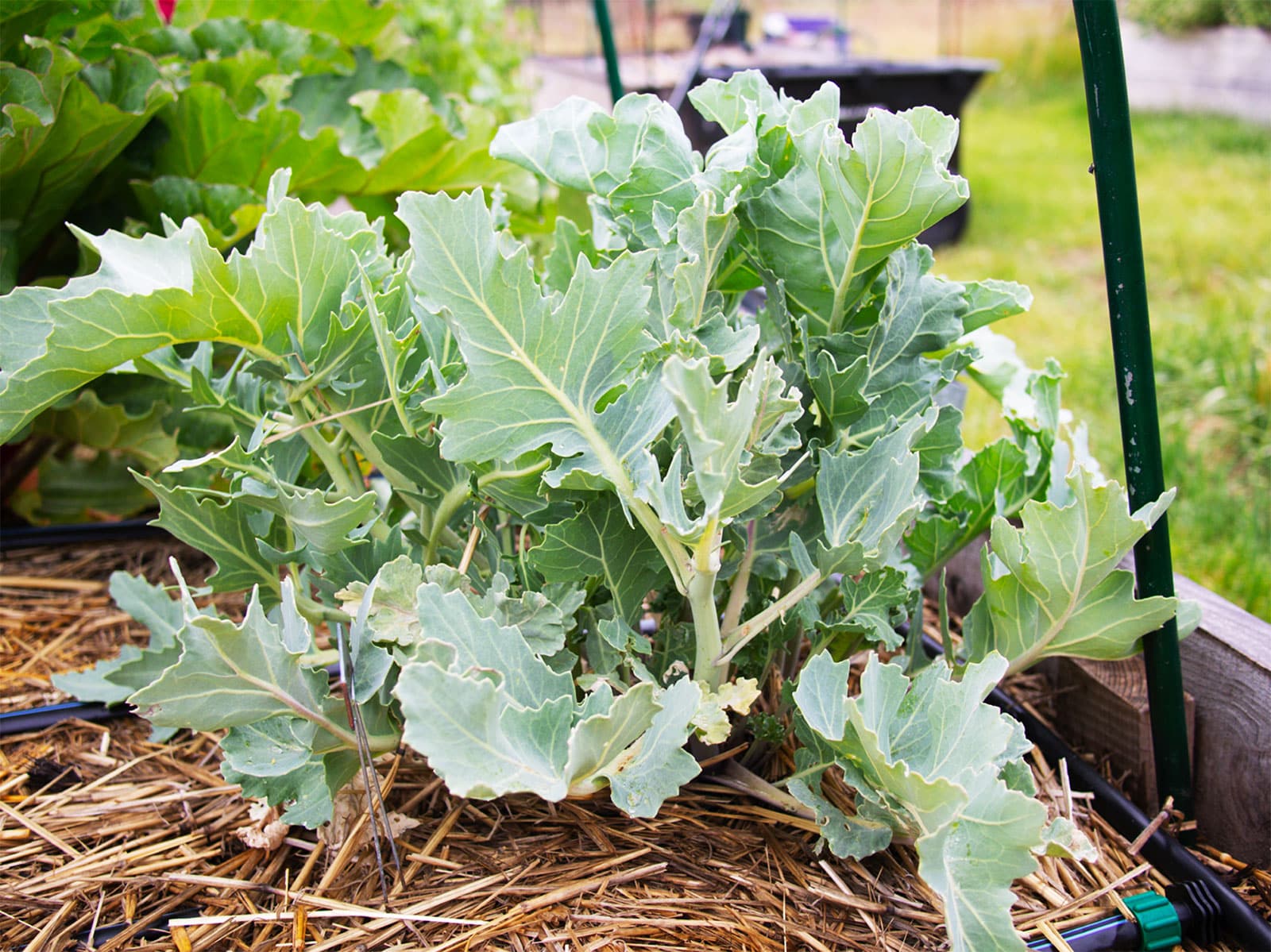
Can you tell I love unusual or forgotten vegetables?
Here’s another one you may not have heard of: sea kale, scientifically known as Crambe maritima.
Naturally found in coastal areas in much of Europe, this halophyte (salt-loving plant) is a member of the cabbage family.
Its leaves can be eaten in a similar manner and taste mildly nutty and bitter. The young shoots are also edible: just boil or roast them like you would asparagus!
Sea kale is a perennial that can be grown in Zones 4 to 8. It likes well-drained, slightly alkaline soil as well as plenty of sun, although it has traditionally also been grown as a blanched vegetable.
As with something like white asparagus, blanching involves covering the shoots when they’re still young, leading to a pale crop with a less bitter taste.
This is a large plant, so give it some room in the garden (at least 2 feet by 2 feet). If your sea kale becomes too large, you can dig it up, divide the thick roots, then replant each piece of root elsewhere in the garden.
Keep in mind that any fragments of roots left in the ground can and will grow into a new plant, so make sure you get them all!
Sorrel (Rumex sp.)
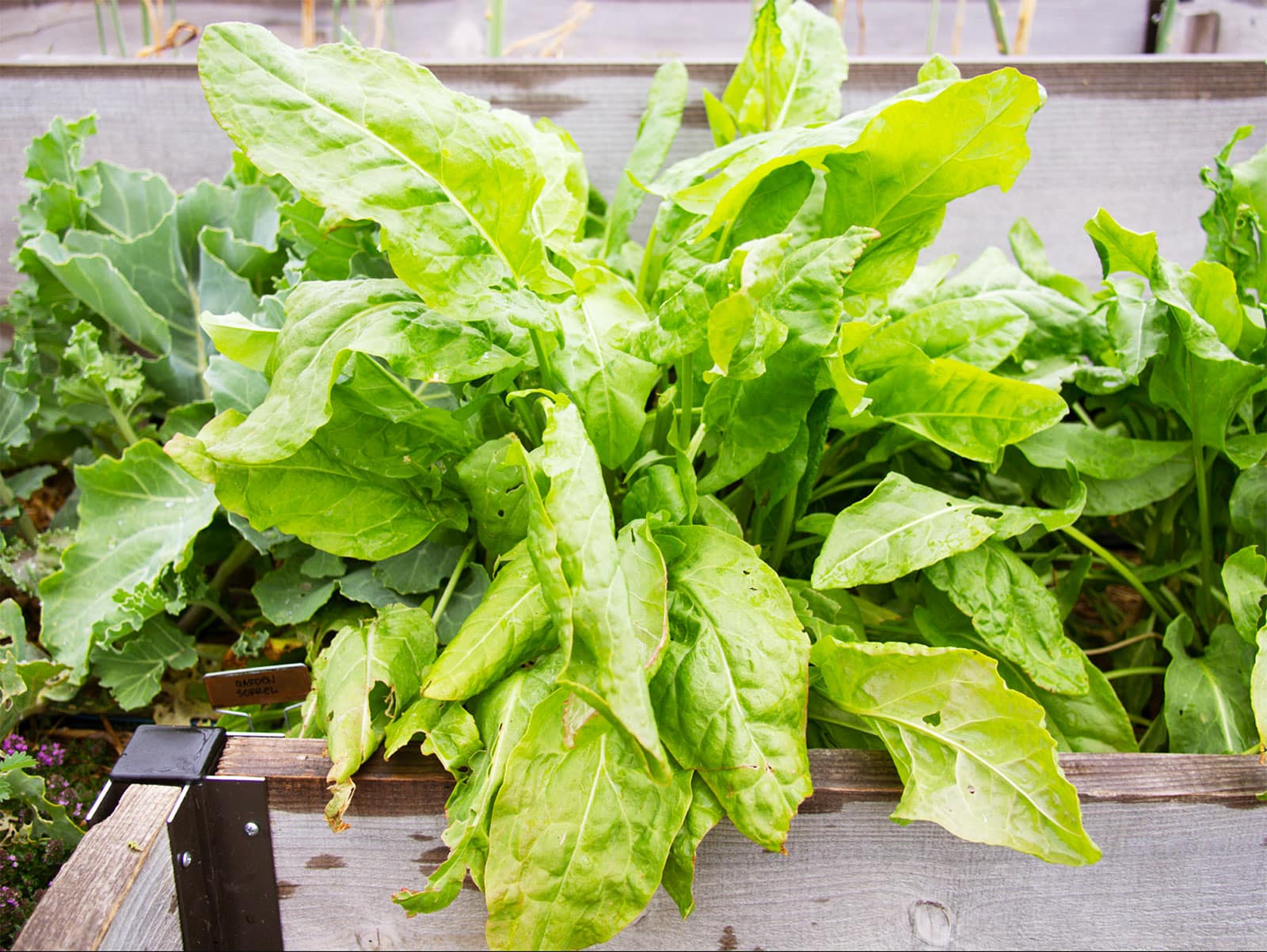
Like the aforementioned good-king-henry, sorrel (also known as dock) is technically an herb, but it’s usually used as more of a vegetable.
If you haven’t tried it, you should! It’s bright and lemony, perfect to liven up a nice creamy leek and sorrel soup, top off a garden vegetable toast, or add a hint of zest to a summer salad.
The image above is common garden sorrel, which is one of the first plants to come up in very early spring for me. (I also grow its cousins, true French sorrel and red-veined sorrel, which I discuss in my post on perennial herbs.)
Sorrel is also similar to good-king-henry in that it’s sometimes considered a bit of a weed… but an edible weed!
That’s good news for us gardeners, as it means it’s easy to grow. It thrives in poor soils and doesn’t mind a bit of shade, especially during summer.
If you’d like to grow sorrel as a perennial, you can do so in Zones 5 and up. Slightly acidic soil is preferable.
You’ll likely be able to harvest the first leaves as little as two months after starting the seeds in spring.
Tree kale/tree collard (Brassica oleracea)
Forget what you knew about kale. In my opinion, tree kale (sometimes called tree collard) is far superior!
This funky brassica gets its name from the fact that it grows very tall (it definitely dwarfs me), very different from the compact rosette shape that we’ve come to expect from this brassica.
It’s also known as walking stick kale (as you can see why), cow cabbage, or Jersey cabbage.
The really cool thing about tree kale is that it’s a perennial plant, which means you can keep picking leaves to use in salads and other dishes pretty much year-round.
This is because, thanks to selective cultivation, it has mostly lost the ability to flower and bolt. Many varieties, such as the popular French D’Aubenton and the English Taunton Deane, taste noticeably milder than regular kale.
You can grow tree kale as a perennial in Zones 7 to 8 and up. It’s not very fussy about things like soil as long as you give it plenty of sun.
Plant stem cuttings during spring or fall and you may be able to enjoy the first leaves within weeks if conditions are favorable.
Turkish rocket (Bunias orientalis)
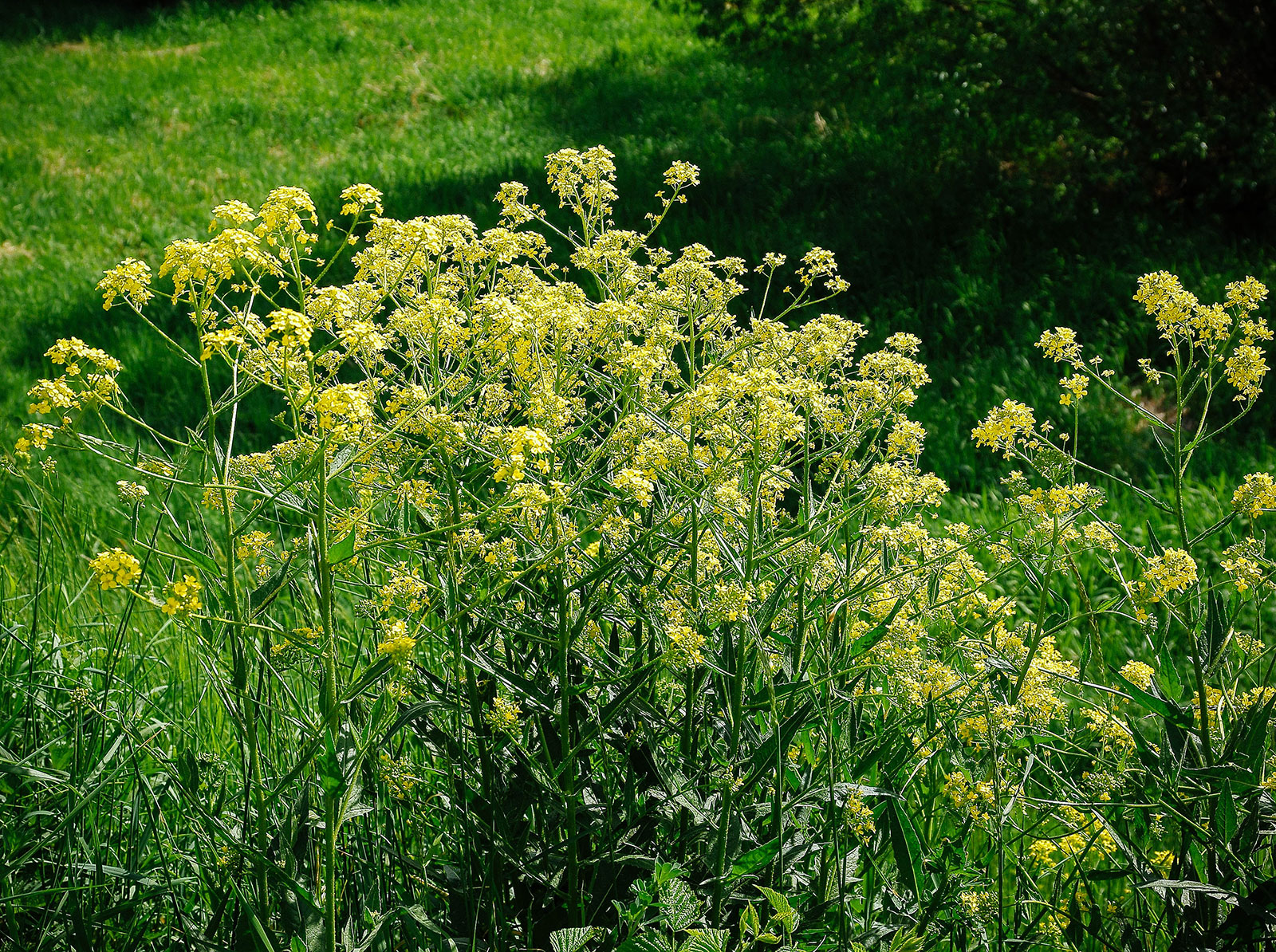
Although this leafy plant (scientific name Bunias orientalis) is known as “rocket,” it’s actually usually eaten more like broccoli rabe.
The immature flowering stems, with some leaves included, can be stir-fried or steamed for a simple side dish. You can also eat the root, which is similar to horseradish but apparently a little milder.
Turkish rocket is quite hardy and grows as a perennial down to Zone 4. Like some of the other plants on this list, it’s basically a weed, so you should have no trouble growing it even if you’re not an experienced gardener.
In fact, think carefully about where you’d like to establish your plant. Once it’s there, you may not be able to get it to go away.
Watercress (Nasturtium sp.)
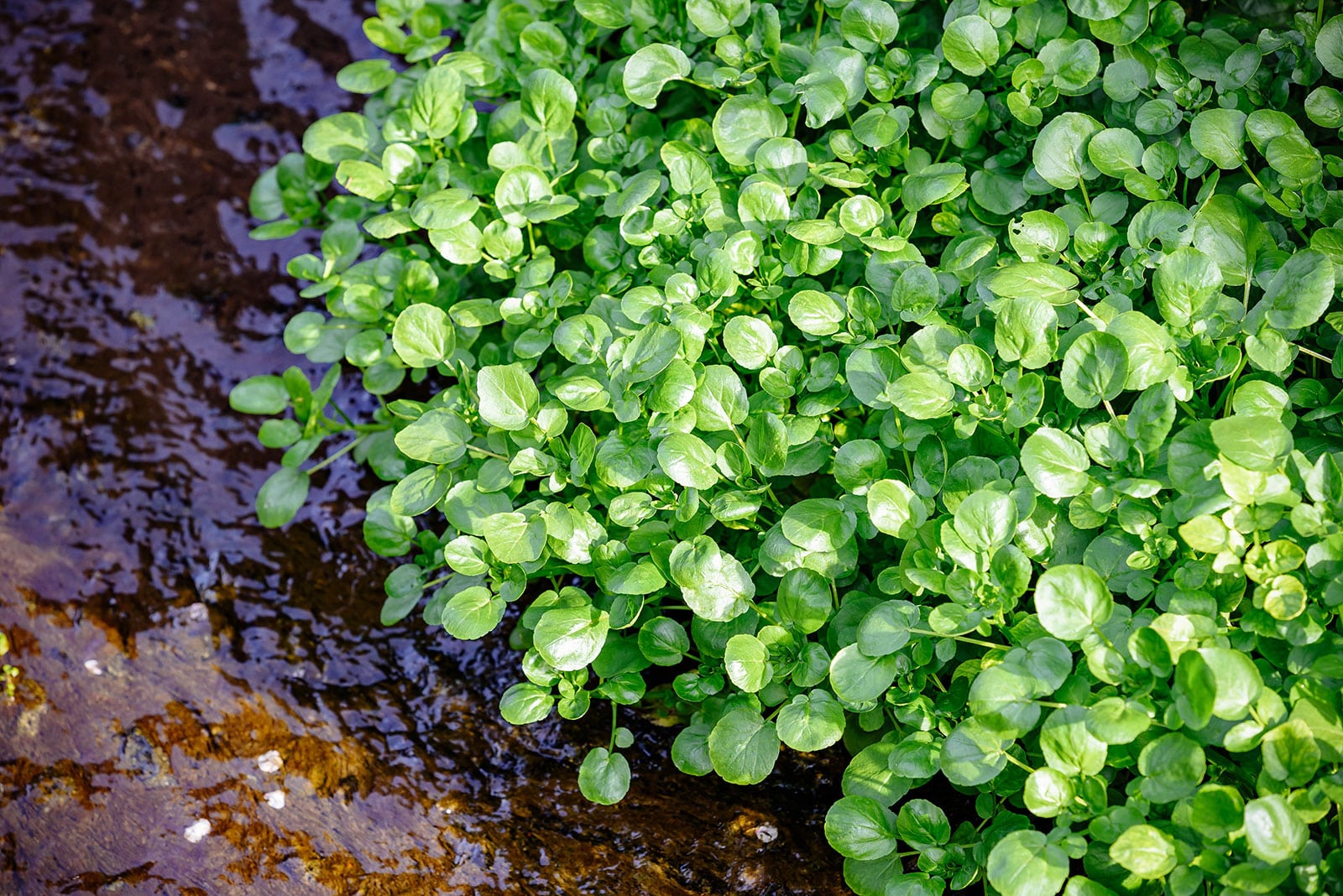
Did you know that humans have been eating watercress for hundreds or maybe even thousands of years?
Being a member of the mustard family, this leafy aquatic plant is mostly grown for its lightly spicy leaves, although its stems and flowers are also perfectly edible.
Aside from the fact that it’s a perennial and pretty prolific, one other thing I like is that watercress doesn’t need full sun to thrive. It’s suitable for growing in a more shaded location; place it next to your garden pond or plant it in a pot of well-draining soil, watering often.
Watercress is ideally suitable for cooler climates, but you should technically be able to grow it between USDA Zones 3 to 11.
Also, don’t be fooled by its species name, Nasturtium—watercress is unrelated to the annual flower commonly known as nasturtium (Tropaeolum majus).
Wild rocket (Diplotaxis tenuifolia)
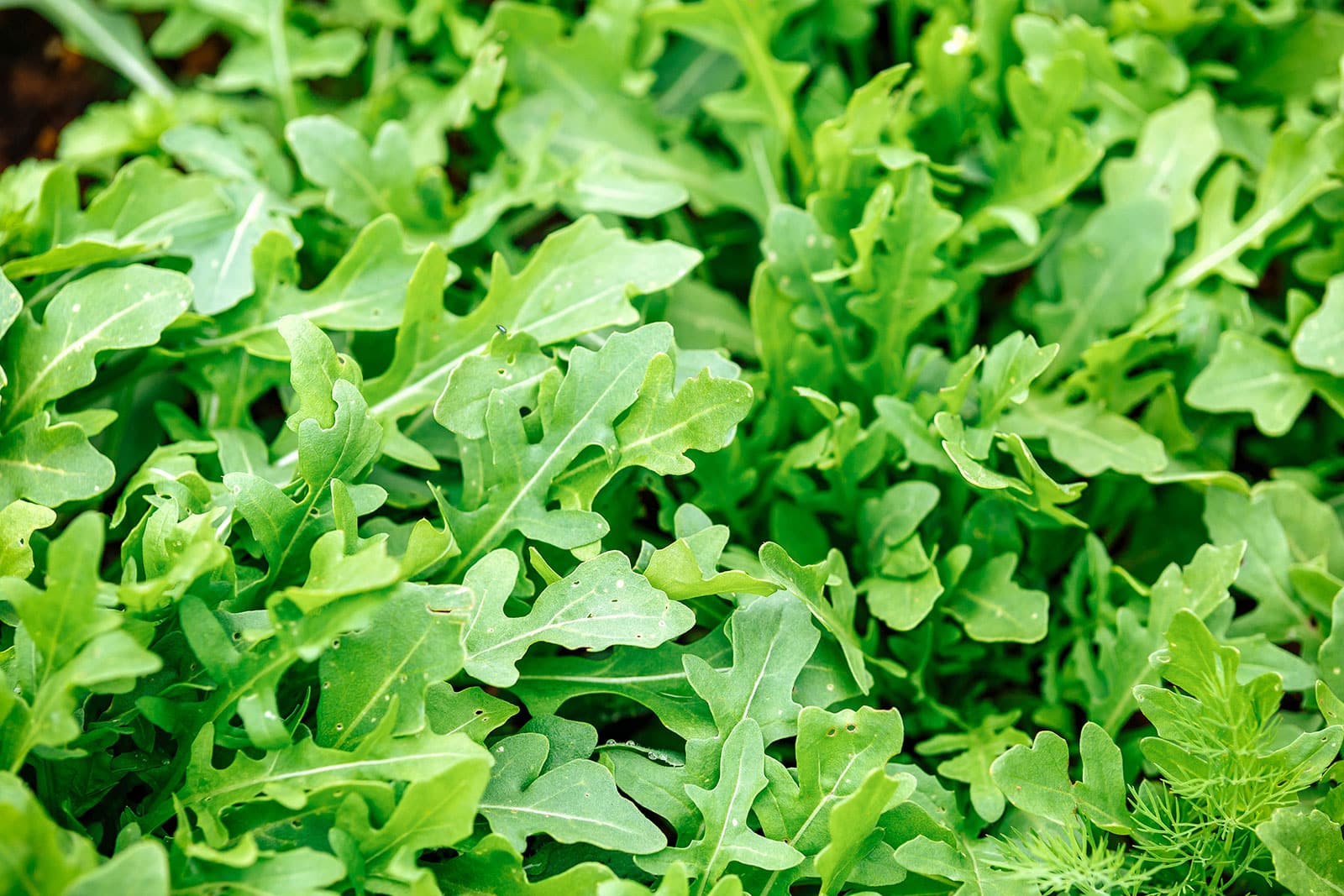
The brassica family is the gift that keeps on giving when it comes to perennial vegetables.
You’re more than likely familiar with rocket, also known as arugula (Eruca vesicaria), which is an annual leafy green popular in salads and on pizza.
But did you know rocket has a perennial cousin called wild rocket (Diplotaxis tenuifolia)?
You can grow wild rocket year after year in USDA Zones 6 to 10. It’s easy to grow; in the Mediterranean, where it’s native, it’s actually a bit of a weed.
The lobed leaves are peppery and nutty like the rocket you’re used to, and the pretty yellow flowers are also edible.
Stems and shoots
Artichoke (Cynara cardunculus)
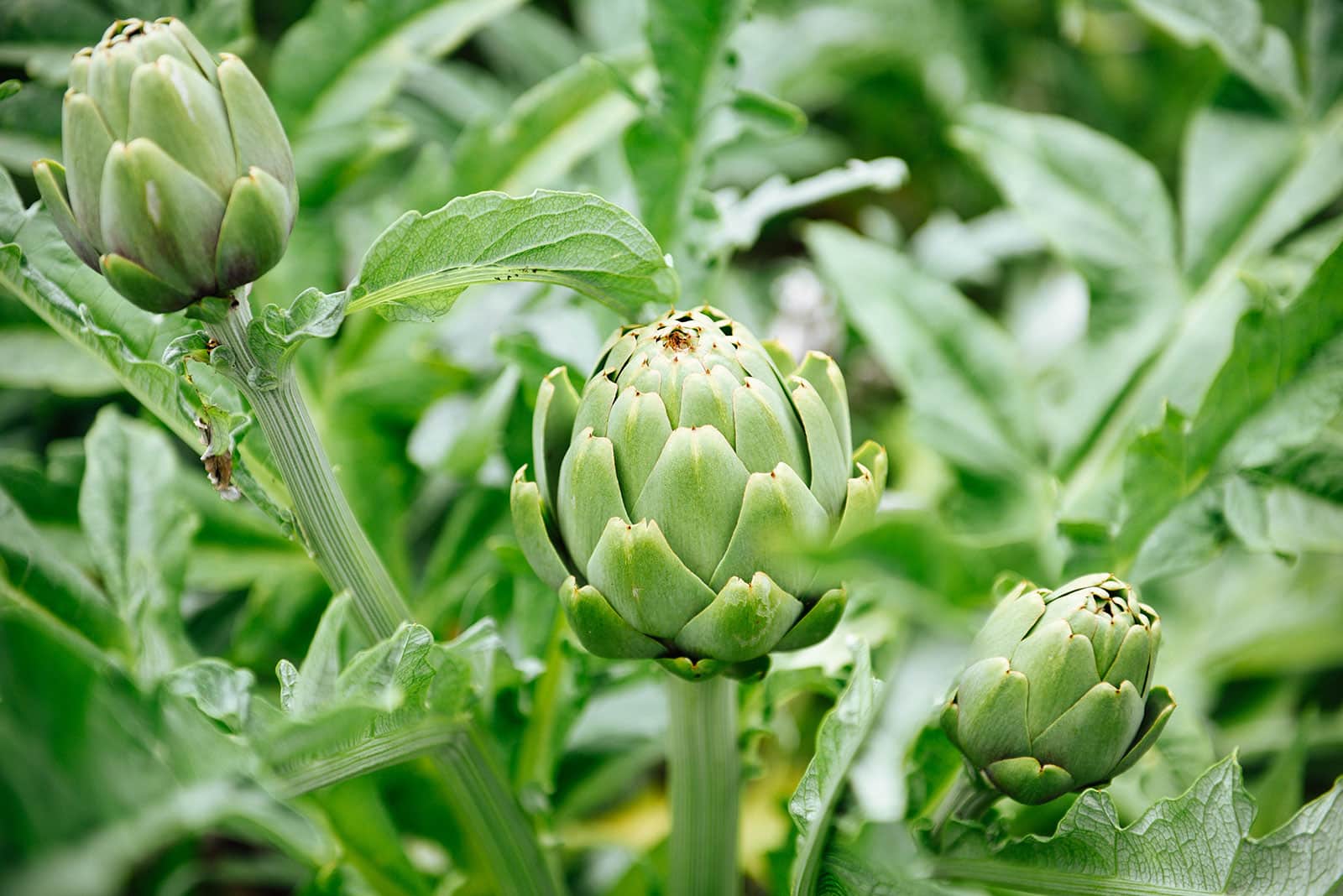
The artichoke (also globe artichoke or green artichoke, scientifically known as Cynara) is actually a species of thistle.
Selective cultivation for flavor and texture, likely dating back to the time of the ancient Greeks, has led to the hearts and parts of the leaves of the artichoke’s budding flower head being quite tasty.
Artichoke is a must in the Mediterranean kitchen, which is unsurprising since that’s where its wild form is naturally found.
And you may be relieved to find out that artichoke buds are actually easier to trim than one might think once you’ve gotten the hang of it!
In Zones 7 and up, artichokes are perennials. In certain climates, like temperate coastal California, they can actually continue producing pretty much year-round.
You can expect up to 10 of the edible flower buds per plant per year, and you don’t have to go green—I loved growing these Purple of Romagna artichokes when I lived in California.
Try my steamed artichoke with pesto crumb if you’re looking for a delicious appetizer or side dish.
Asparagus (Asparagus officinalis)
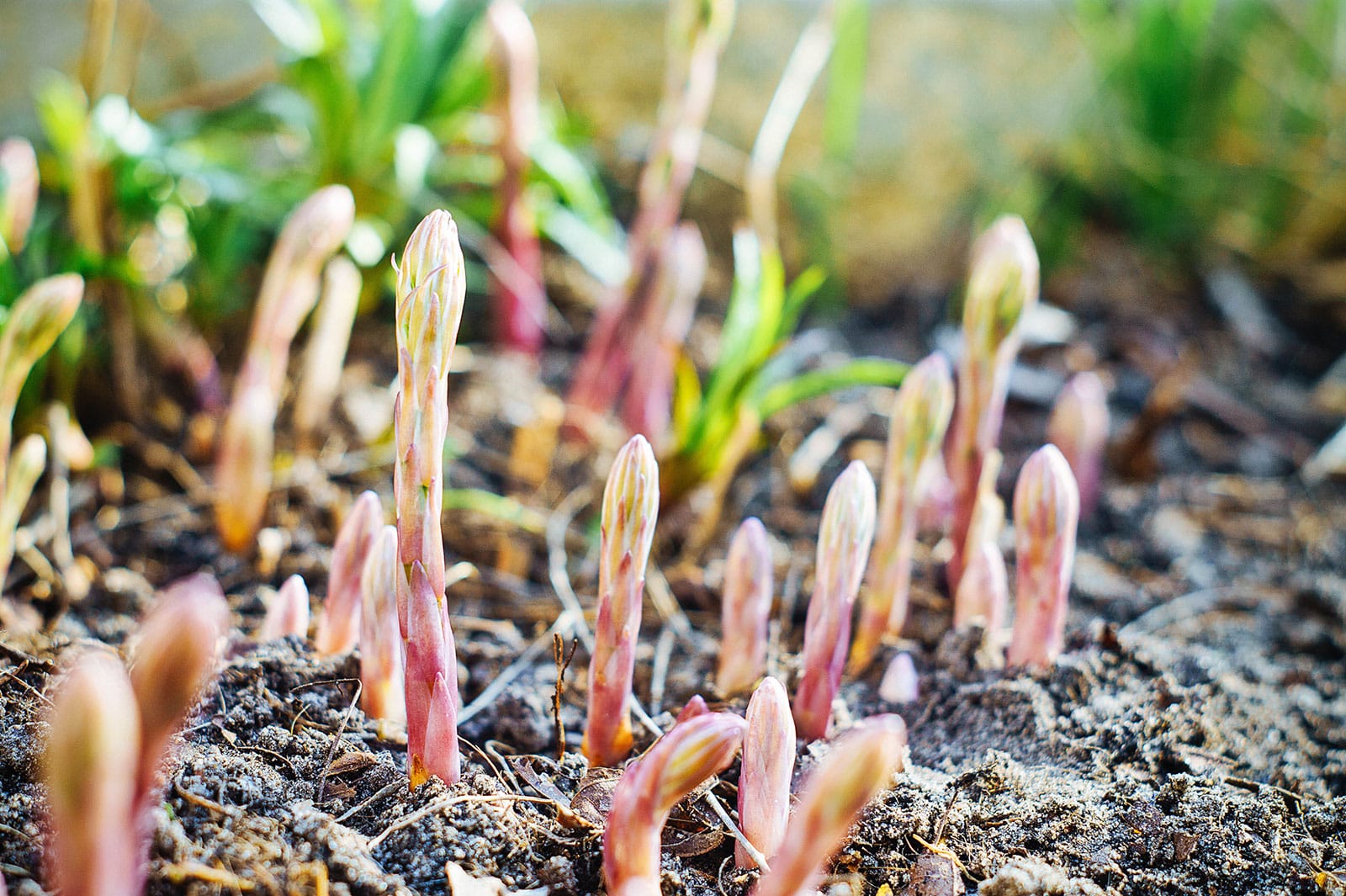
Asparagus is perhaps one of the most popular perennials to grow, and for good reason: An asparagus plant can actually continue producing for a decade or two, making this species a great choice if you’re looking for a vegetable plot that you can enjoy year after year (and possibly even pass down to your kids, haha).
That’s a lot of risotto, frittatas, and tasty grilled steak accompaniments.
Another great thing about asparagus is that this crop, which was likely originally found in Europe and western Asia, is very hardy.
You can grow it between USDA Zones 3 to 8, depending on the exact variety. (Here’s my step-by-step guide on growing asparagus from crowns.)
It can take the plants a while to get going, but once they do, you can expect a sizable harvest every spring even from a relatively small bed.
Cardoon (Cynara cardunculus)
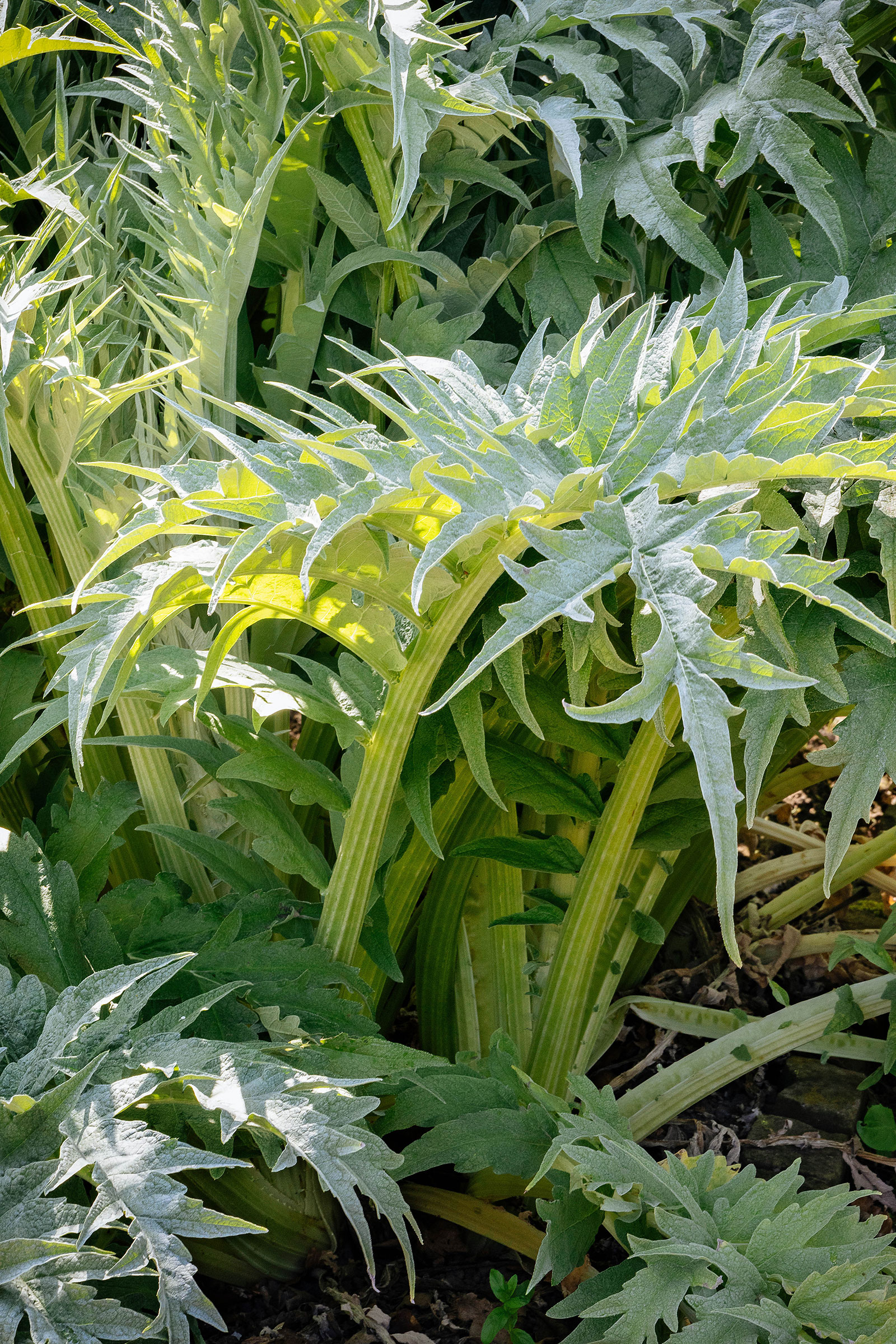
Have you heard of the artichoke’s wild cousin, cardoon? Also known as the artichoke thistle, it’s actually the exact same species, even though it looks a little different.
Cardoon is reasonably popular as a landscaping plant thanks to its pretty purple flowers, but what many people don’t know is that it’s actually also edible.
In the right climates (Zones 7 and up), the species works well as a perennial.
Like the artichoke, cardoon has a long history in the Mediterranean. It’s still used in local cuisines here, particularly in France, Italy and Spain, where the celery-like leaf stalks are blanched and then used in gratins, soups and stews.
Give it a try! All it needs to grow year after year is plenty of sun and a nice, well-draining soil.
Rhubarb (Rheum sp. hybrid)
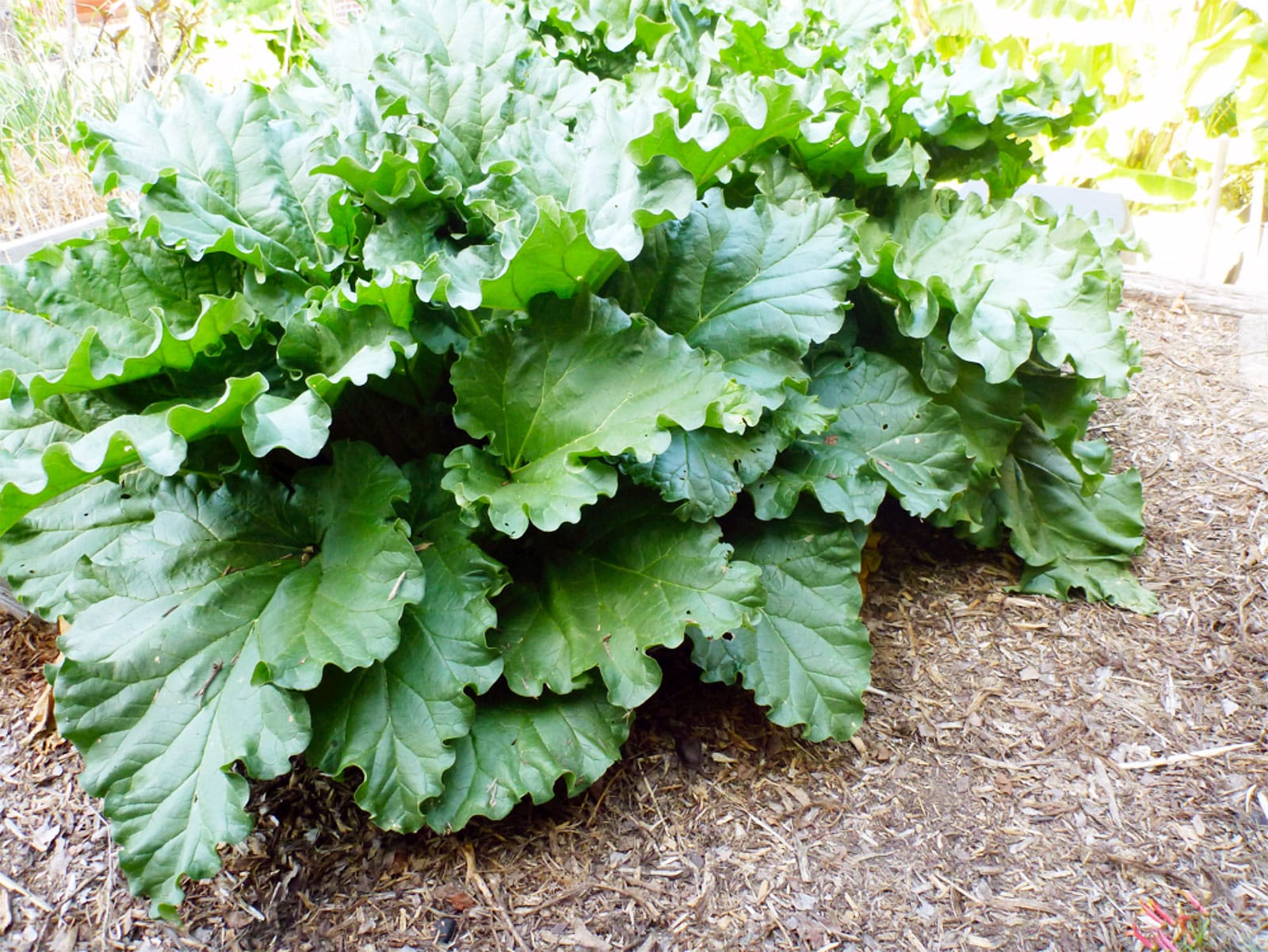
Although the sweet-tart flavor often puts rhubarb in the fruity or dessert category, it’s a vegetable, and a versatile one at that. It can be used in both sweet and savory dishes (as well as these spicy rhubarb margaritas, which may partially explain why I love it so much).
The colorful stems shine in pie fillings, as savory rhubarb pickles, in compôtes, or even as the star ingredient in my tasty rhubarb-vanilla bean syrup.
Growing rhubarb is a breeze, and given that the species is naturally found in rather chilly areas in Siberia and China, it’s hardy as a perennial all the way down to USDA Zone 3.
In fact, since the plants need an extensive chilling period yearly, they really do best in cooler climates and will start to struggle in Zones 7 and up!
Plant your rhubarb in a spacious spot (at least 3 feet by 3 feet) during fall or spring and you should be able to get the first harvest in a year or two. You can pick the stems from late spring all through summer; compost the leaves, as they are high in oxalic acid and should not be eaten.
Tubers
Groundnut (Apios americana)

The humble groundnut (Apios americana) or hopniss isn’t exactly a very well-known crop.
It doesn’t help that it shares its name with a bunch of other plants in the same family—the legumes, scientifically known as Fabaceae—including peanuts. But if you’re not familiar with it yet, maybe you should be!
A perennial vining species, the groundnut is actually a native plant. It’s naturally found from southeastern Canada down to the eastern and central US, where its edible tubers long formed a source of food for Indigenous Americans.
They taste great when treated like potatoes: try boiling, roasting, or mashing them.
You can grow groundnuts as perennials in a sunny spot in your garden between Zones 3 to 7. Plant the tubers in spring, give the vines a nice trellis to keep them from growing too unruly, and water regularly to hopefully be able to start harvesting around early fall.
Horseradish (Armoracia rusticana)
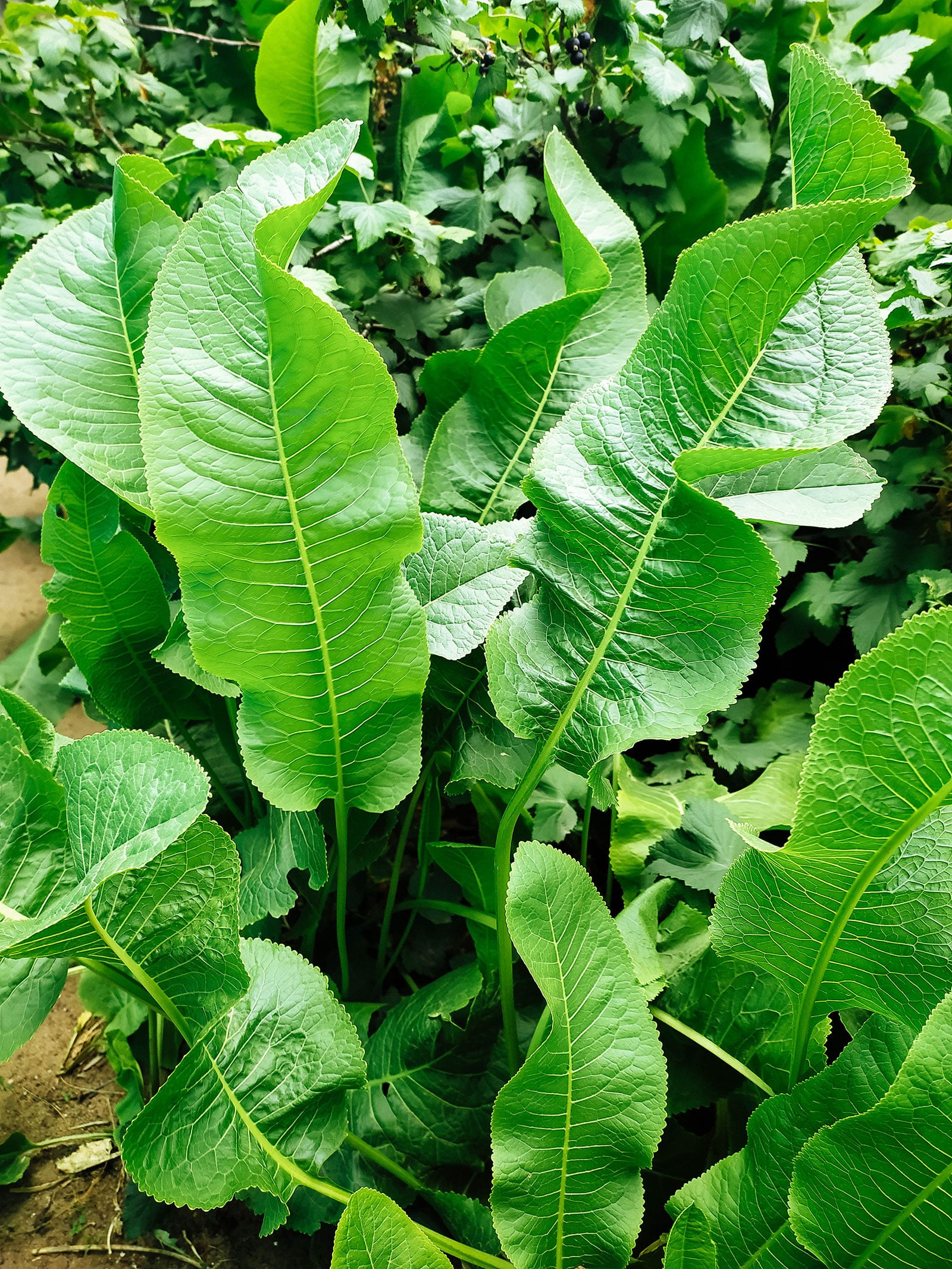
It may not be the first thing you think of when it comes to growing your own vegetables, but horseradish is actually quite easy to maintain.
And it’s a super hardy perennial, too: It can be grown year-round anywhere between Zones 2 to 9.
Fresh horseradish packs a much more powerful punch and has a more complex flavor than the jarred kind, so if you enjoy that eye-watering mustardy experience as much as I do, you’ll love growing your own. Use it for sauces, anything you’d otherwise use mustard for, or even to make your own wasabi paste for sushi!
Plant horseradish in well-draining, rich soil in early spring or late fall. Harvest when the leaves die off; you can store the roots over winter for months to come.
Because horseradish is notorious for “escaping” into a yard (some might call it invasive), I recommend planting this in its own raised bed or in a large planter (like a half-barrel).
Jerusalem artichoke (Helianthus tuberosus)
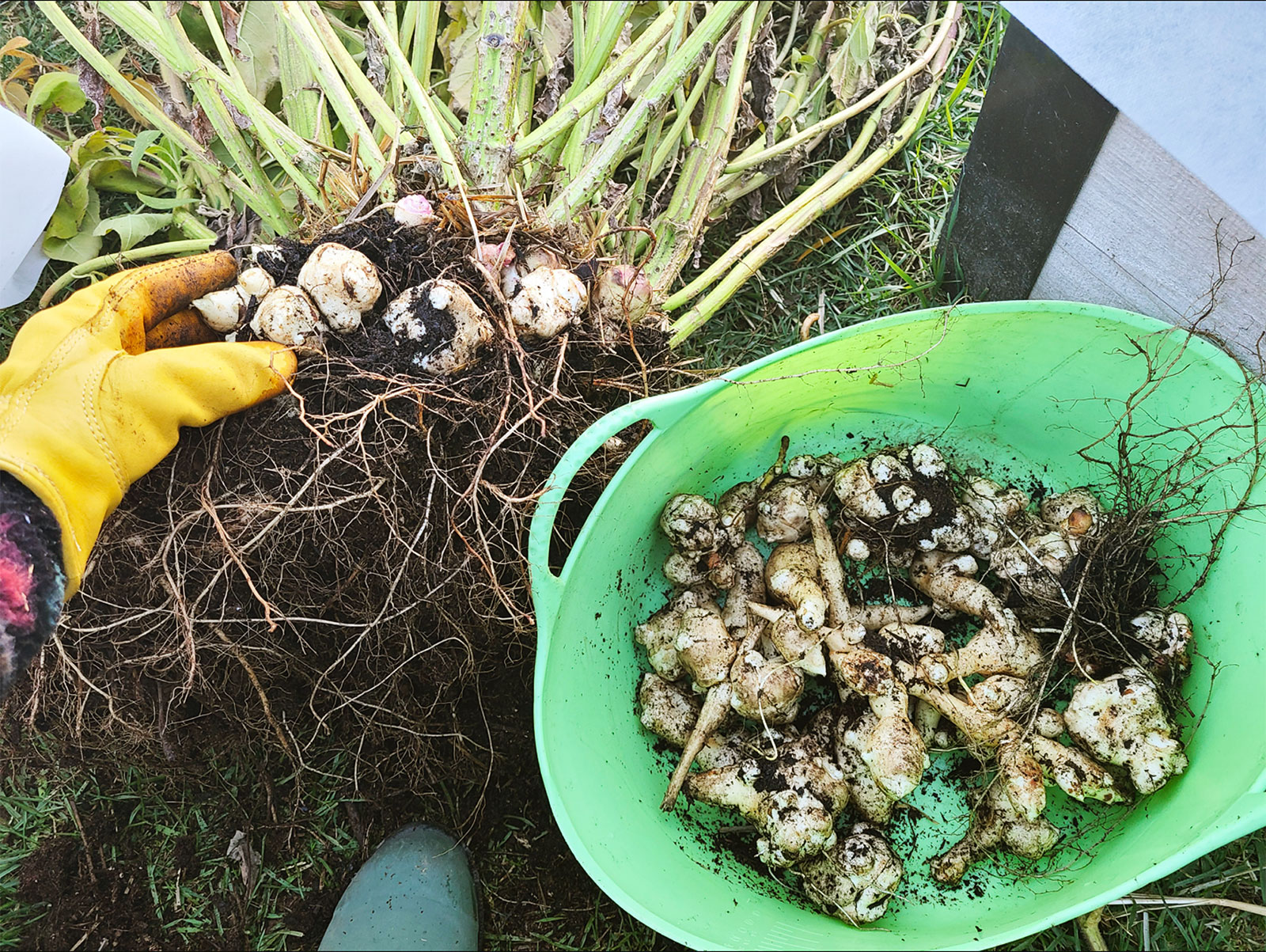
If you’re wondering why we’re discussing artichokes twice, don’t be fooled.
The Jerusalem artichoke may bear the same name, but it bears little resemblance to true artichokes. It’s also not from Jerusalem.
Common plant names are weird like that, which is why it can be handy to call things by their scientific denomination. In this case: Helianthus tuberosus.
Now, if you’re thinking that Latin name also sounds familiar, you’re correct. Jerusalem artichokes are members of the sunflower family! (And probably why it’s also known by its other common name, sunchokes.)
Unlike their showy cousins, though, sunchokes are not cultivated for their flowers but for their fleshy tubers.
Jerusalem artichoke tubers look somewhat like ginger, but are used more like potatoes—except they’re less starchy and can also be eaten raw. You can roast them, mash them, turn them into soup or even add them to your salads.
This plant is perennial in Zones 3 to 8, so have a look at my full guide to growing Jerusalem artichokes and give it a try in your own garden.
Sweet potato (Ipomoea batatas)
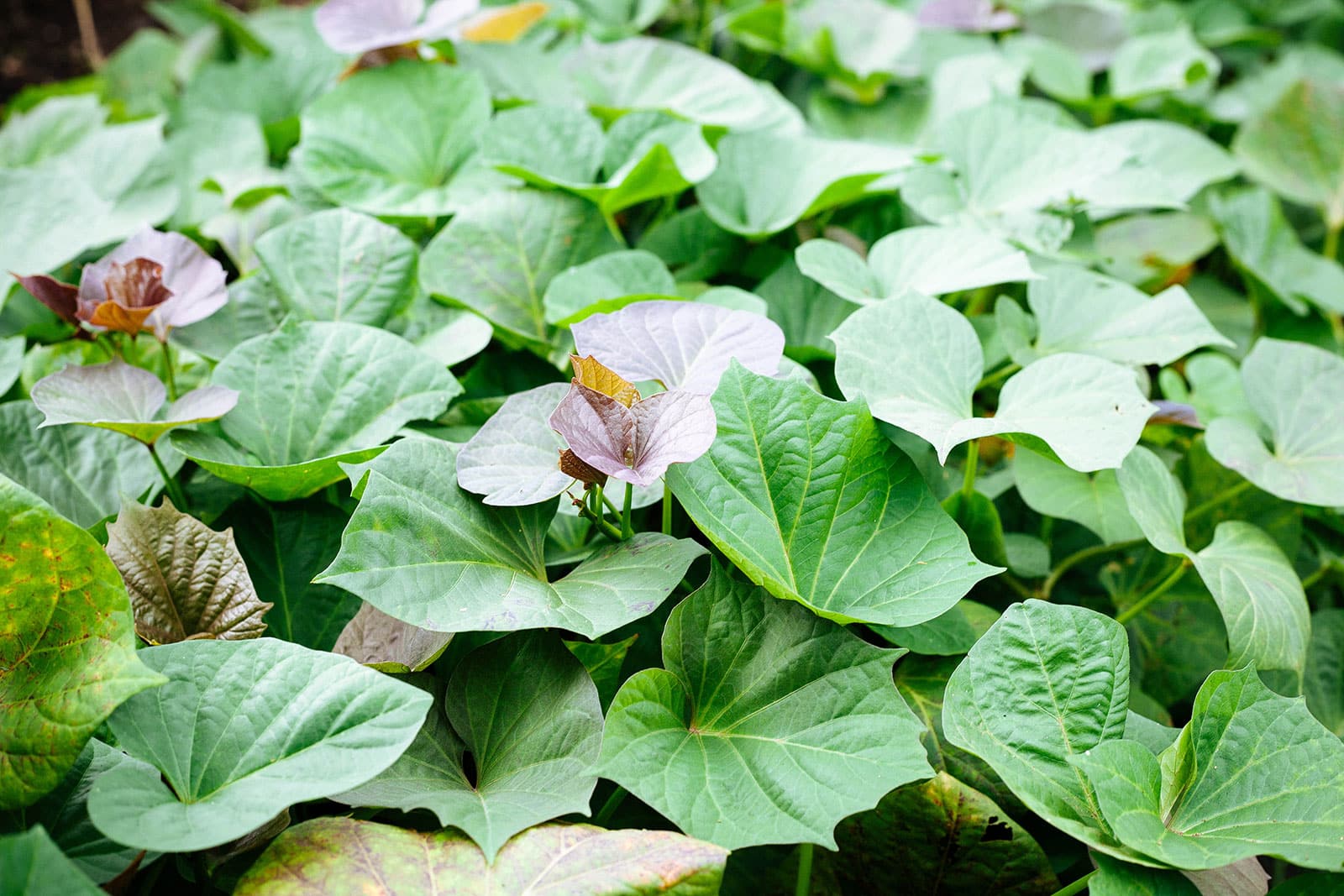
The sweet potato, a tropical vining plant from central to northern South America, can absolutely be a perennial provided you live in a warm enough climate to keep it going year-round.
Those in USDA Zones 9 and up can enjoy picking the leaves (which are also edible) and tubers whenever they want, as long as the plant receives enough water and nutrients to produce them.
Sweet potatoes are easy to grow. You can even start your vines from a supermarket tuber!
Just provide rich and well-draining soil and plenty of sun, plus a trellis if you don’t want the plant to trail all over the place.
Plenty of moisture is important for a good sweet potato harvest, although the vines themselves are actually pretty drought-tolerant.
Did you know? Sweet potato leaves and stems are mild and tender, similar to spinach. They’re great in stir-fries. I have a recipe for sweet potato leaves in my book, The No-Waste Vegetable Cookbook.
Vegetables you didn’t know were perennials
Chayote (Sechium edule)
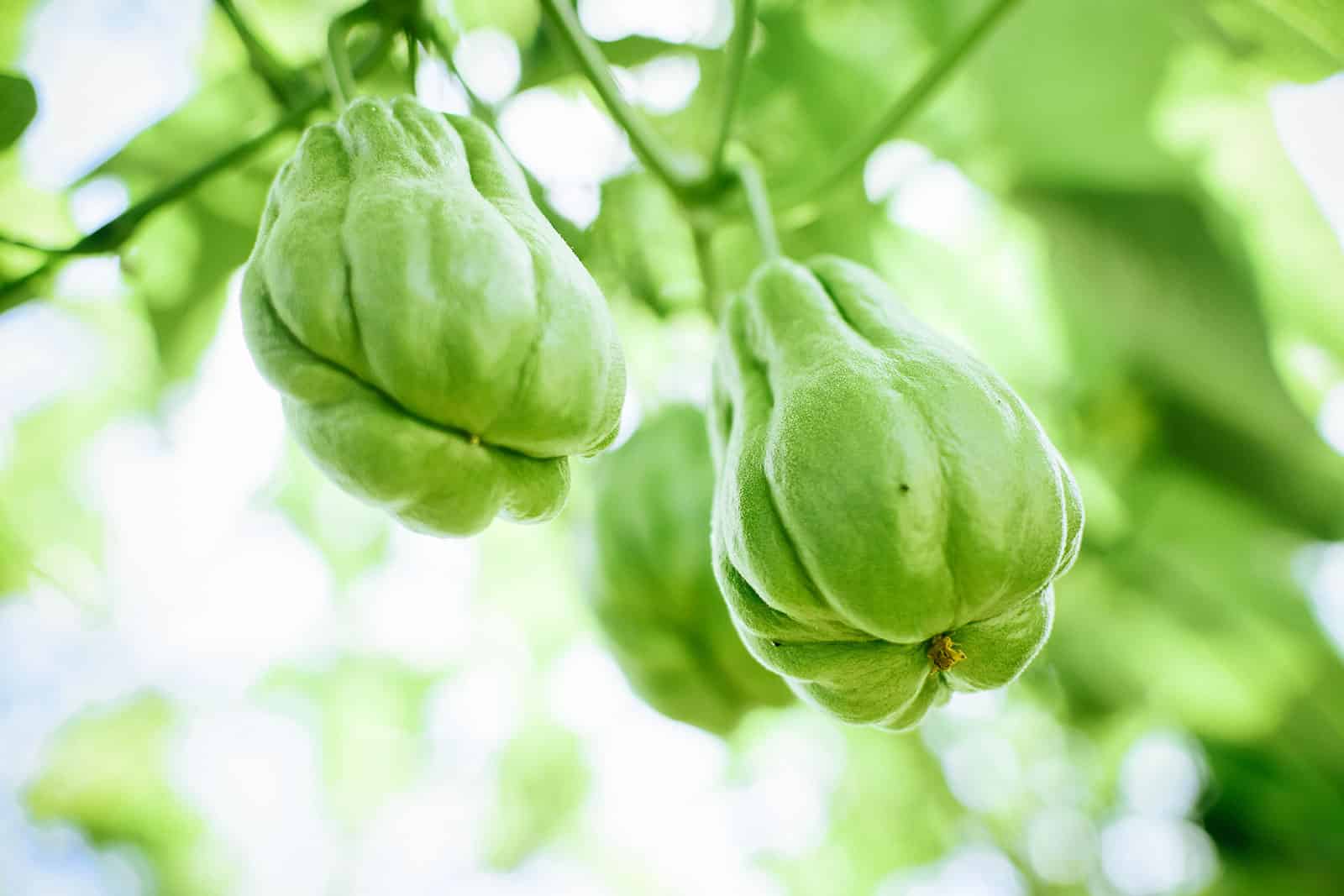
Chayote always makes me smile, because if you turn this vegetable on its side and look at the end (on the side opposite the stem), it looks like a squash missing its dentures!
The chayote (Sechium edule) is a member of the gourd family, making it a cousin of crops like squash, melon, and cucumber. It’s popular in Central and South America, as well as in Creole cuisine, but not very widely used in the US in general.
Chayote fruit works well in all sort of dishes, from Chinese-style stir-fries to stuffed with shrimp like they do in Louisiana. (Personally, I love it in soups.)
What some folks don’t know is that the plant also produces edible tubers, which you can use like a potato, and the leaves and young stems can be eaten as well.
This tropical likes it nice and warm, so it can be grown as a perennial from Zones 9 to 11. The vines like plenty of sun and water. It requires protection if there is any danger of frost.
Hot and sweet pepper (Capsicum sp.)
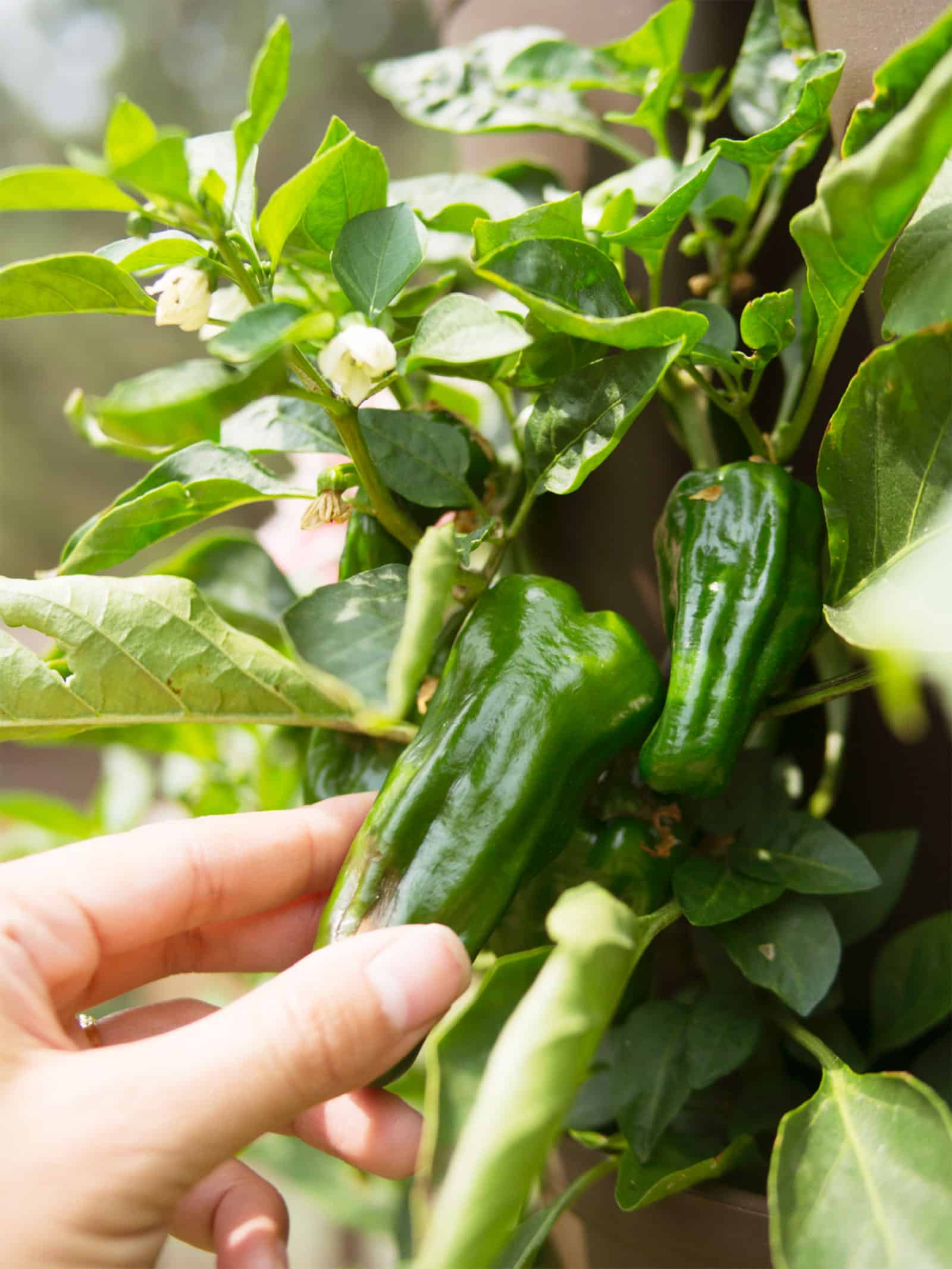
Wait, peppers can be perennial?!
Yep! Native to Central and South America, the genus Capsicum will happily grow year-round as long as the plants are not exposed to frost.
You can grow both sweet peppers and chili peppers (including one of my favorites, the fish pepper) as perennials in Zones 8 to 11. Give them a sunny spot, provide a stake or cage if necessary, and remember to take protective measures if frost is predicted.
Did you know? Unlike most other nightshades, pepper plants have edible leaves. You can use them for soups, to make kimchi, or in stir-fries.
Read more: 11 Vegetables You Grow That You Didn’t Know You Could Eat
Lima bean (Phaseolus lunatus)
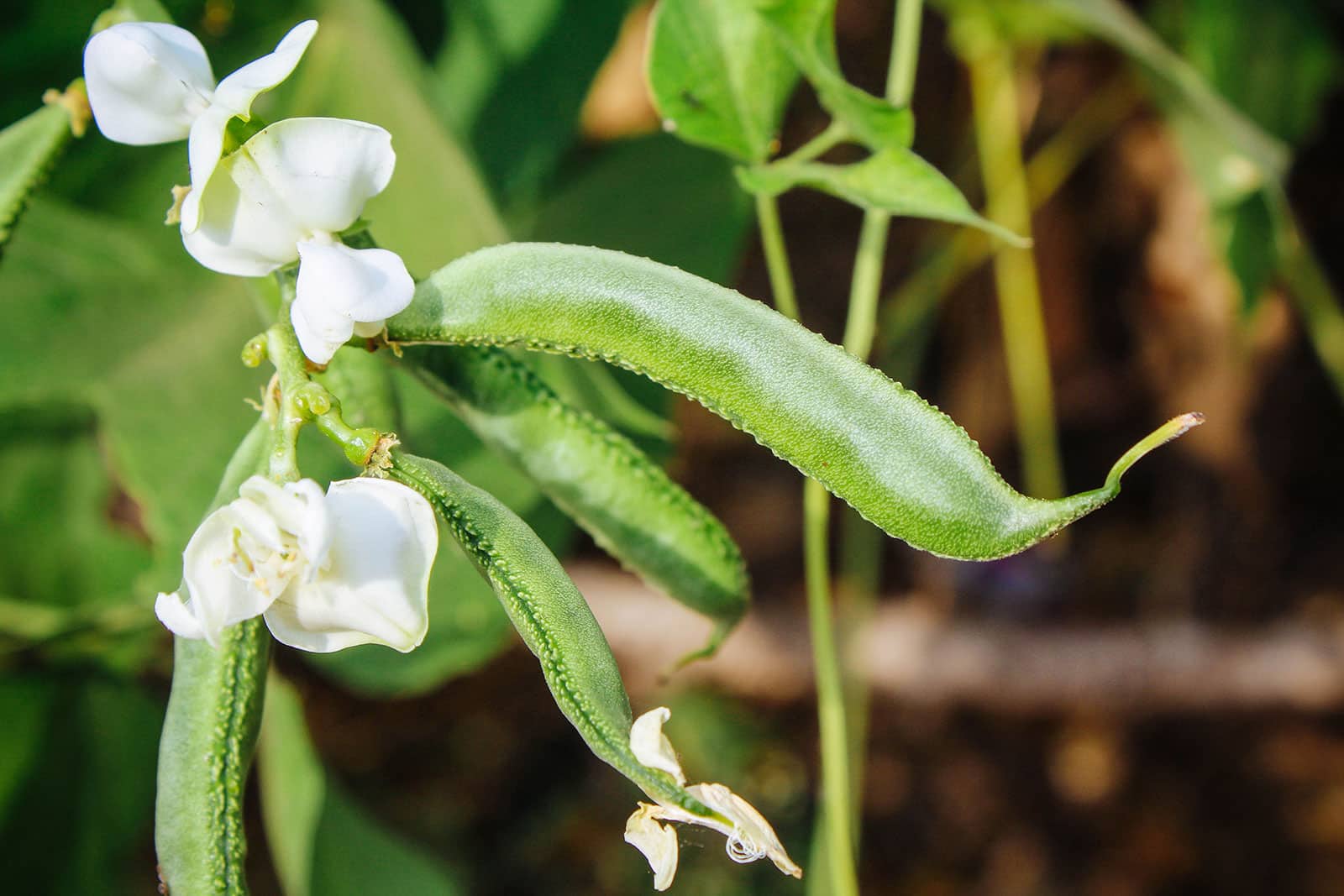
I love lima beans!
Whether it’s the green baby version or the larger white one (often called butter bean), these legumes are highly nutritious and just work fantastically in a range of salads, soups, and stews. Did you know they’re one of the classic ingredients for a traditional Valencian Spanish paella?
Like the aforementioned Central-South American veggies, lima beans can be grown as perennials in warmer climates. In Zones 8 to 11, you can plant them in spring after the risk of frost has passed.
Provide well-draining soil plus plenty of sun and water and you’ll usually be able to start harvesting after around three months.
In areas that do get somewhat of a winter season, you can cut the plants down to the roots and cover with several inches of mulch so they can resprout when things warm back up. If your local climate is warm year-round, you can just leave them to do their thing.
Scarlet runner bean (Phaseolus coccineus)
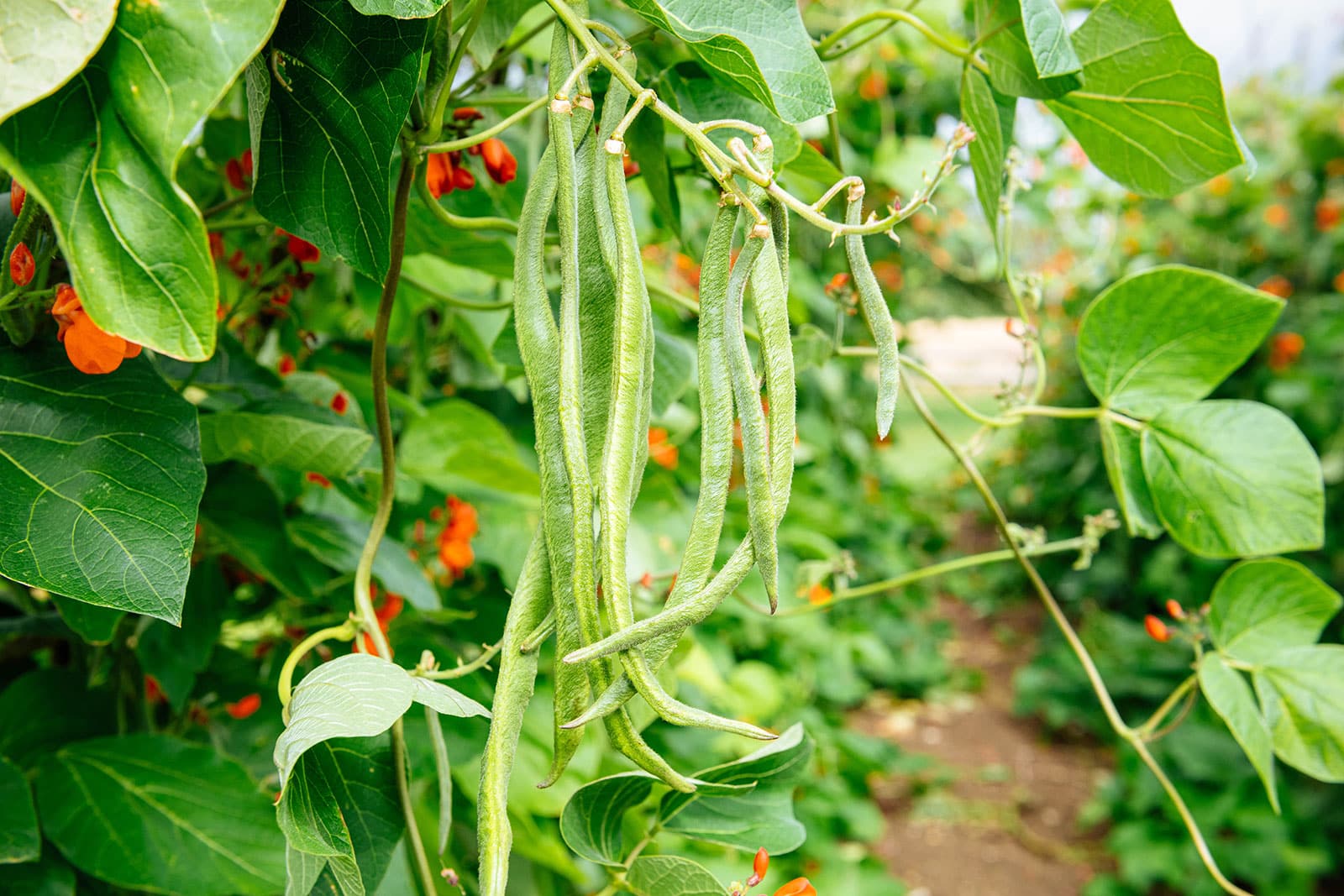
The pretty scarlet runner bean (Phaseolus coccineus) is native to Central America, although it’s made its way around the world and back since its was more widely introduced.
The species is a great addition to your garden: It produces edible beans and roots, the blooms are beautiful and the vigorous vines make it a great ornamental.
Another cool thing about these beans is that, unlike some of the other American vegetables we’ve just discussed, they naturally grow in cooler climates at higher altitudes.
This makes them a little more flexible in terms of temperature, meaning you can grow them as perennials in Zones 7 to 11. You may even be able to stretch this to Zone 6 with adequate winter protection.
Scarlet runner beans need a structure to climb, so be sure you plant them along a fence, provide a trellis, or train them up your corn stalks in a Three Sisters garden. You can grow them in rich, well-draining soil in a sunny spot in your garden.
Tomato (Solanum lycopersicum)

Indeed, tomatoes can be perennials. It’s a matter of climate: This nightshade is originally from Central-South America, meaning it requires tropical temperatures to be able to keep growing year-round.
Just like peppers, you can grow tomatoes as perennials outdoors in Zones 8 to 11, making sure to protect them from frost if things do get chilly in winter.
Be sure to choose an indeterminate (vining) variety and pick a nice and sunny spot to plant it.
The plants can keep providing tomatoes for years, although their productivity does eventually drop off with age.
















Thanks for the post. I have had a problem with the environmental, time management and financial waste that comes from planting so many annuals that do not seed naturally themselves or produce quick enough if they do. I am open to more for my acidic zone of 7b plus limited greenhouse space.
I thoroughly enjoyed this very informative article. Thank you
Nice list! You missed a few of the warm climate species that I was just starting to grow in Florida as Zone 8 transitioned to Zone 9. I’d have to go over my records to generate a list. If anyone emails me for it, I’ll work it up. My absolute favorite from your list is Apios americana. There are two distinct populations, triploid in the north and diploid in the south. So the Northern strain only reproduces asexually. The southern strain also produces seed which we cooked up like beans or lentils. The seed also self-sowed. A plant of damp to outright wet places, A. americana tolerates saturated soil and, on my Florida chinampas, thrived over a year of inundation. However, my wife and I found that the texture after protracted flooding was not to our liking. Unfortunately, we had just given up on chickens, we were traveling a bit and the cost of someone coming in was exorbitant. Also, racoons tore the door right off the chicken coop and did their frenzied slaughter thing. Otherwise we would have cooked up the tubers and used them as a feed supplement. They have about three times as much protein as Anden potatoes (the ‘normal’ kind). Apios tubers are borne on small stolons, like large beads on a string. If you don’t harvest them, they get bigger year by year, so they are a good backup crop. You don’t want them in your annual vegetable garden, because they take over. During the protracted flood I mentioned above, they took over our main chinampa. Achira was another perennial vegetable that thrived there, as well as galangal, a close relative ginger. Astonishing, cassava survived longer that I would ever have imagined a crop of the DRY tropics could. Taro became a weed, almost impossible to get rid of, similar in that regard to Jersulam artichoke. At least you can eleminate the latter by fencing pigs in the infestation for a year or so. The best book on perennial vegetables in the US is called, unsurprisingly, Perennial Vegetables by Eric Toensmeir, an American permaculturist. Another book almost as good, but with a European slant, was done by a UK tree crops guy who has one fantastic work in that field. Again, if anywants the details, email me. My ancient brain gradually and sometimes not so gradually leaks memories. A number of tree leaves are also edible such as mulberry and I think linden (verify this before trying it). Linden (Tilia cordite) is the European cousin of basswood so maybe basswood species such as big leaf basswood (T. americana) have edible leaves. I’ve seen info about edible leaves of woody plants scattered here and there over the years but never got around to systemizing a list. For an excellent reference of edible plants, fungi an bacterial cultures, get Stephen Faciola’s (spelling?) Cornucopia II, which is probably still available used. Again, if you can’t find it, let me know and I’ll dig up the exact reference. (It is somewhere across the room and my wife called me to lunch a while ago.)
Where did you get the seed to the tree kale and the nine star broccoli and the Lima bean phaseolus lunatic?
hey, I just discovered your site online and love it as it’s very practical. Much of this I know already and theres also plenty of unfamiliar stuff in here that you make very easy to learn. It’s not an over whelming amount information on each plant, which makes it easier or me to determine what can be planted where, and with what accompanying companion plant! I primarily clean out vacant urban lots in York PA and put in urban gardens ( community gardens) but I usually end up doing most of the work as there’s a lot of elderly folks who cant do what they used to do, physically. I specifically look for plants that are very good at removing toxic ingredients in urban soils, ( sunflowers) and love perennials as it makes my life a while lot easier where I dont have to dig entire gardens each year. I’m looking to learn more about perennial herbs and any kind of low moisture plants ( as I have to pay for water). Beautification is a huge part of what I do, so I need plants that ” keep up appearances” and don’t look weedy.